Lake Titicaca Travel Guide: Planning Your Trip
TripSavvy / Chris VR
Lake Titicaca, the cradle of Incan civilization and the origin of the Inca Empire, is the largest lake on the South American continent, straddling the border between Peru and Bolivia. An interesting Lake Titicaca fact is that, by some definitions, it's the highest navigable lake in the world at an astounding 12,500 feet of elevation, making it higher than Mount Fuji in Japan. Lake Titicaca is too chilly for swimming, but this alpine body of water does offer gorgeous views of the Andes, boating trips to islands made of reeds, and an intimate look into the Indigenous cultures that have called the Titicaca home for hundreds of years.

Planning Your Trip
- Best Time to Visit : Because of the lake's high elevation, the temperatures stay cool throughout the year and nights often dip below freezing. The dry season lasts from April to November and the wet season from December to March. June to August are the most popular months to visit, but April and May are excellent for sunny days, minimal crowds, and lush vegetation coming off of the rainy season.
- Language : Spanish is spoken throughout the Lake Titicaca region, as well as Indigenous languages such as Aymara and Quechua. On some of the islands on the lake, Indigenous languages are spoken exclusively, so make to book a tour with a guide who can translate for you.
- Currency : The type of currency depends on which side of the lake you're on. On the Peruvian side, you'll need Peruvian soles. If you're in Bolivia, you'll need bolivianos. Credit cards are not widely accepted, so bring cash with you. You'll have a much easier time if you bring smaller denominations.
- Getting Around : Most travelers stay in Puno, Peru, or Copacabana, Bolivia. You can get around either city using inexpensive taxis, but you should ask your accommodation to call you a cab rather than hail one off the street. For getting around the lake's islands, there are many boat excursions to choose from.
- Travel Tip : Even though it's usually chilly, the high elevation means the sun rays are especially strong. Pack sunscreen and don't forget to put it on before going out.
Things to Do
Lake Titicaca is too cold to swim in, so don't expect to arrive and lay out on the lakeshore or go for a dip. The real draw here is taking in the breathtaking nature of the Andes and learning about the rich cultural history of the Titicaca's inhabitants. Some of the attractions are only accessible from the Peru side while others are only accessible from the Bolivia side, so if there's something specific you want to see, make sure you head to the right destination.
- Floating Reed Islands : One of the most famous attractions of Lake Titicaca is the man-made floating reed islands. Located just off the coast of Puno in Peru, the Uros people have been weaving together islands that they live on for hundreds of years. You can visit them for a day or really immerse yourself in Uros culture by choosing to spend the night in a homestay.
- Isla del Sol : According to Incan mythology, the god Huiracocha emerged from the Isla del Sol , or Island of the Sun, and created the world. The island was one of the most sacred places to the Inca and served as the focal point for Lake Titicaca's spiritual energy. The Isla del Sol is located on the south side of the lake near Copacabana, Bolivia. Together with the neighboring Isla de la Luna , or Island of the Moon, both islands still contain Incan ruins to be discovered.
- Island Boat Tour : There are lots of islands around Lake Titicaca, so the best way to explore them is to visit as many as possible on a full-day boat excursion. Leaving from Puno, you'll see not just the floating man-made Uros islands but also actual islands where other cultural groups live. One of the most visited is the Isla de Taquile, which is especially known for the hand-woven textiles sewn exclusively by the men. Amantaní is another nearby island inhabited by Quechua people who farm quinoa on terraced fields.
What to Eat and Drink
Trout from Lake Titicaca is the dish you'll most commonly see whether you're on the Peruvian side or the Bolivian side, typically accompanied by quinoa or salchipapas , french fries served with slices of hot dog. Trout is actually an invasive species in the lake that was imported by the U.S., so you're doing the ecosystem a favor by consuming as much of it as possible. Quinoa also shows up all over local cuisine, either in soups, steamed with vegetables, and creamed.
If seafood isn't your cup of tea, you'll also find what could be considered Peru's national dish, lomo saltado . Strips of beef are stir-fried with local vegetables and served over rice, which is practically a staple of chifa cuisine, or the fusion of Chinese cooking with Peruvian ingredients.
Where to Stay
Puno on the Peruvian side of Lake Titicaca is the most popular base for travelers exploring the lake. It has the most hotel and restaurant options and direct connections to Lima and Cuzco, but it can also feel very touristy. Copacabana in Bolivia, on the other hand, is less developed than Puno and the choice for travelers who want to get off the beaten track. Accommodation options range from backpacker hostels to luxury villas with views of the lake, but you'll find the top-tier choices in and around Puno.
If you really want to enjoy your stay on Titicaca, you can spend the night on one of the many floating islands right off Puno. Homestays on the Uros Islands are common, allowing visitors to spend the night in a family home and share a meal with the island's residents. Suasi Island is an actual island, not a man-made floating island, and it's also much farther away—about five hours by boat. But it's one of the most remote options for your stay and perfect for those looking for tranquility, isolation, or just some good old adventure.
Getting There
Getting to Lake Titicaca most likely entails getting from Cuzco or Lima to Puno on the Peruvian side, or traveling from La Paz to Copacabana on the Bolivian side. There are also buses that cross the border and travel between Puno and Copacabana, taking about four hours of travel time.
How to Get There From Cuzco
Cuzco is the closest big city to Puno and you can travel by plane, bus, or train. Flights from Cuzco to Lake Titicaca arrive in the city of Juliaca. The time in the air is only an hour, but it's another hour of travel time from Juliaca to Puno by car. Buses for Puno typically leave Cuzco in the morning and take about eight hours to reach the lake. Trains are the most scenic option, but also the slowest and oftentimes the most expensive. The Andean Explorer and PeruRail are the two companies with train service between the cities, and the journey takes over 10 hours.
How to Get There From Lima
Lima is much farther away from Lake Titicaca than Cuzco and going by land isn't a viable option. Thankfully, flights from Lima's airport to Juliaca only take about an hour and a half, so you can still reach the lake easily even if you aren't passing through Cuzco.
How to Get There From La Paz
Travelers who are visiting Copacabana or the Bolivian side of Lake Titicaca generally start in La Paz, Bolivia's capital city. The only way to travel is by bus and the journey takes about four to five hours. Prices and bus standards vary wildly, and it's generally worth paying a bit more to have a more comfortable ride.
Culture and Customs
The lake's importance has endured for centuries and the local Indigenous cultures—of which there are several—still consider the lake to be a sacred place. The most prominent cultures in the region are the Aymara, the Quechua, and the Uros, each with its own language and customs.
Due to overfishing in the lake and over-tourism, the traditional ways of life of the local residents are in danger. Many of the accommodations and homestays charge a supplement to support the local community, so don't pass over places that charge this extra fee. When booking tours of the lake or the islands, seek out guides that belong to the Titicaca's Indigenous groups. For example, the people of Isla Taquile started their own community tourism group to offer excursions and take back control from outside companies that were profiting off of the Indigenous residents.
Money Saving Tips
- In general, Bolivia is less expensive than Peru . If you're traveling on a budget, focus your trip on the Bolivian side of the lake.
- When looking for boat tours from Puno or Copacabana, don't accept the first offer you hear. There are plenty of options in both cities, so shop around a little and feel free to haggle.
- Flights are convenient when you're short on time, but the most affordable way to travel around Peru is by bus.
- The wet season from December to March is the least busy time to visit and when you're most likely to find travel deals. Rain isn't constant, so you may get lucky and have a fairly dry trip. On the other hand, if you encounter heavy rain it really limits how much you'll be able to explore Lake Titicaca.
The Floating Islands of Lake Titicaca
Peru Route Planner: Classic Itinerary
Your Trip to Lima: The Complete Guide
The Top 20 Things to Do in Peru
What Languages Do They Speak in Peru?
Where to Go in 2021: 10 Future Trips You Can Start Planning Now
Facts About Lake Titicaca
Spanish Phrases You Need to Know in Peru
Is It Safe in Peru?
Belize Travel Guide: Planning Your Trip
Mérida: Planning Your Trip
Bali Guide: Planning Your Trip
Your Trip to Aruba: The Complete Guide
Your Trip to Udaipur: The Complete Guide
How to Travel From Lima to Cusco, Peru, by Bus, Car, and Plane
Top 10 South America Travel Destinations

- Salkantay Trek
- Inca Jungle Trek
- Huchuy Qosqo Trek
- Ausangate Trek
- Vilcabamba Trek
- Choquequirao Trek
- Huayna Picchu
- Altitude Sickness
- Packing List
- Humantay Lake
- Lake Titicaca
- Nazca Lines
- Rainbow Mountain
- Get A Trek Quote
Lake Titicaca – Ultimate Guide To The Birthplace of The Sun
Lake Titicaca is the world's highest large lake. This great body of water is also an important part of South America’s history. Some of Peru's most famous legends center around Titicaca.
There's more than just fish in these waters. An ancient city lies beneath the surface and ruins dot the shores. The islands (floating or not) are windows back in time to a simple way of life.
In this article, I will tell you how, why, and when you should make a trip to ‘The Birthplace of the Sun.
Looking for a short tour? Here are some of my favourite tours in Lake Titicaca:
- Combined Uros and Taquile Island Day Tour (leaves from Puno)
- 2-Day Budget Lake Titicaca Tour (incl. Uros, Amantani and Taquile)
- Full Day Puno Tour (incl. Lake Titicaca, Uros and Taquile)
- Floating Islands Day Tour (with lunch on Taquile)
- 2-Day Luxury Lake Titicaca Boat Tour (leaves from Cusco)
See more Lake Titicaca day tour options.
Lake Titicaca Facts
What does titicaca mean.
The name ‘Titicaca’ (pronounced ti-tee-kaa-ka) cannot be traced back to one single language.
In Aymara, Titi can mean either ‘puma’ or ‘lead’. In the same language, caca- means ‘white hairs on the head’. The best translation of Titicaca is ‘a grey or rock-coloured Puma’.
Others believe that the name comes from a sacred rock located on Isla del Sol (The Sun Island) called Thaksi Cala. It’s possible that with years of mispronunciation, Thaksi Cala could have developed into Titicaca.
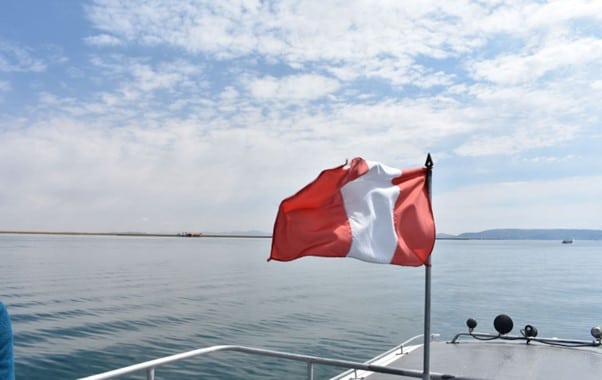
Is Lake Titicaca The Highest Lake In The World?
If you take a tour of the lake, you will likely hear that Titicaca is the highest lake in the world. This is not entirely true. If you have been to Huaraz in northern Peru (which I highly recommend), then you’ve probably trekked to higher, much smaller, lakes.
Titicaca is the highest navigable lake in the world. Basically, it is the biggest high-altitude lake. The mountain lakes are not big enough to accommodate boats.
The elevation of Lake Titicaca is 3,812m (12,507ft) above sea level. It fluctuates by about 2.5m (8.2 ft), getting higher over the rainy season. By sheer area and volume of water, Titicaca is also the largest lake in Latin America.
The highest point on Lake Titicaca is Pachamama mountain (4130m / 13, 550ft). You can hike up to this point on Amantani Island .
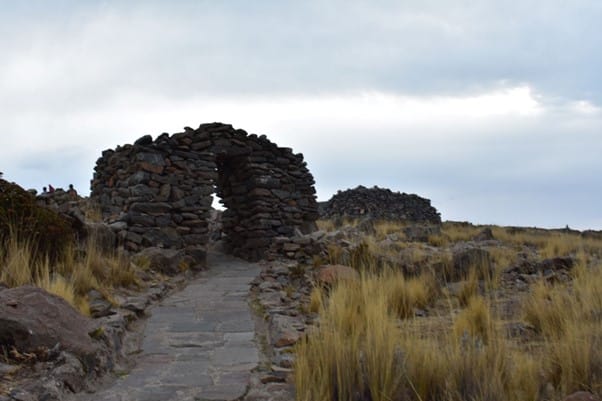
Pachamama on Amantani island
Is Lake Titicaca in Peru or Bolivia?
This is true - Lake Titicaca is in both Bolivia and Peru. The massive lake straddles the border between these countries.
There is a heated debate between Peruvians and Bolivians as to who has the bigger portion of Lake Titicaca. Regardless, you can reach beautiful islands and see epic sunsets on either side.
Please Note: You might be planning to cross the Yunguyo border between Puno (Peru) to Copacabana (Bolivia) by bus. If you take this route in either direction, the bus needs to cross the lake on a barge.
How Deep Is Lake Titicaca?
The average depth of Titicaca is between 140-180m (460-600ft). The deepest part of the lake is in the northeast corner, off Isla Soto. Here, the bed is 284m (932ft) below the surface. That’s equivalent to a 60-story building!
Is Lake Titicaca Shaped Like A Puma?
Well actually, Lake Titicaca is shaped more like a puma hunting a rabbit.
The puma is a sacred animal for the Incas, representing the power of the Earth and the land of the living. It's not surprising that this form is identified in many natural features.
Incan architects also designed settlements and structures in this shape. For example, the city of Cusco is shaped like a puma.
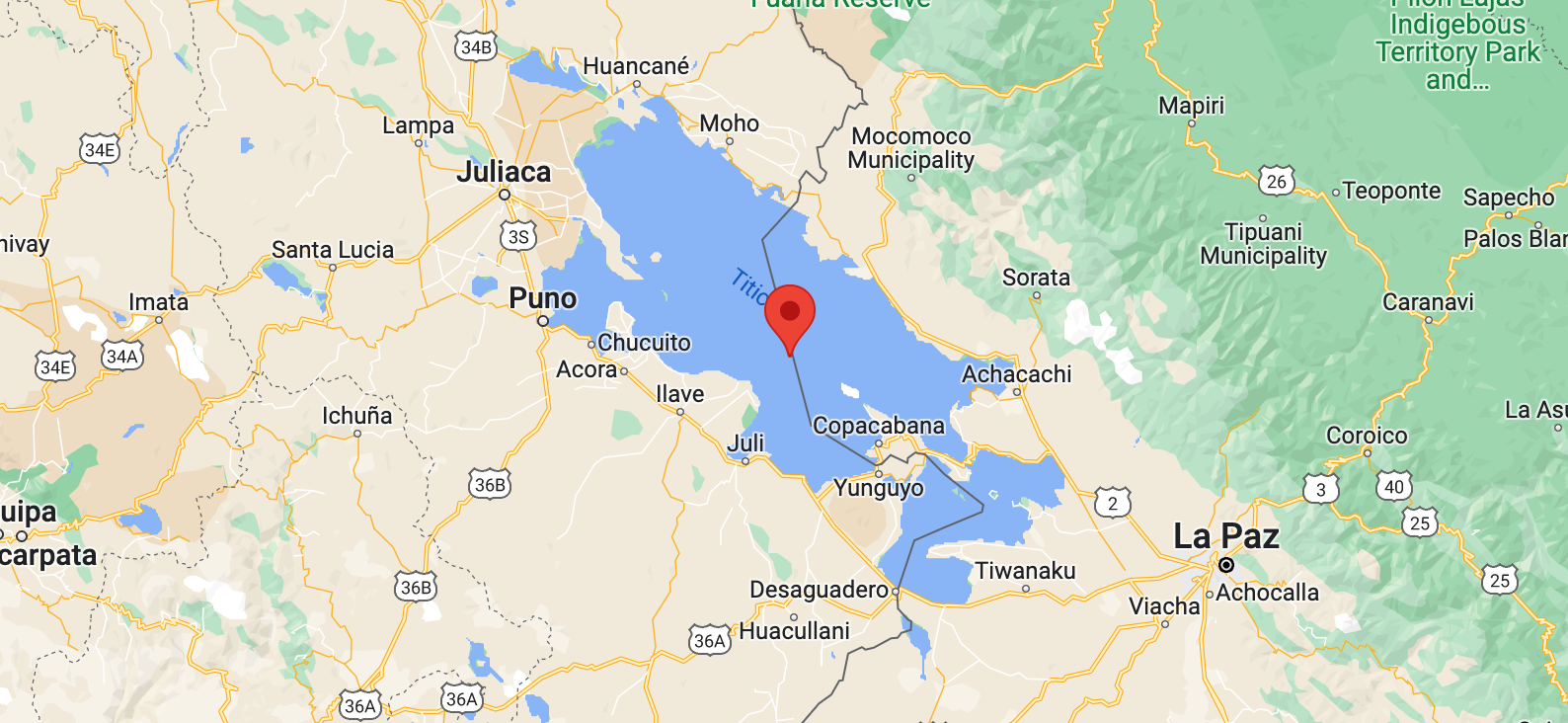
Is Lake Titicaca A Protected Area?
Titicaca was designated as a Ramsar wetland site in 1998. A large part of it is protected as a national reserve. 90% of the lake’s fish, including native Killifish and catfish, are found nowhere else in the world.
The lake, its shores, and islands are home to 530 aquatic animal species. This includes threatened species like the Flightless Titicaca grebe and the Titicaca Water frog . These massive amphibians can weigh up to 1kg (2.2. lbs.) and live in shallow areas.
Trout were introduced in 1939. These invasives make up a large part of the local diet. You’ll find fresh trout on the menu of almost every restaurant in Puno or Copacabana.
You may also like...
- Best restaurants in Cusco
Where to stay? Here are 7 of my favourite accommodation options on Lake Titicaca and in Copacabana:
- Los Uros Hostel (affordable and private accommodation)
- Duque Inn (private option at budget prices)
- Qelqatani Hotel (more upmarket option)
- Totora B&B (guest-house experience at backpacker prices)
- Hostal Sonia (cheap and comfortable accommodation)
- Hotel Onkel Inn Torres (pricey but with excellent views)
- Titicaca Lodge Peru (pricey but lavish accommodation)
See more Lake Titicaca and Copacabana accommodation options.
Why Is Lake Titicaca Important?
From a historical and cultural perspective, there are several reasons why Lake Titicaca is important to this region of South America.
History of Lake Titicaca
Lake Titicaca is thought to be over a million years old. People inhabited the lake area, even before the Incan civilization. An underwater Lake Titicaca temple and ruins have been found that date back as far as 1,500 years. This is believed to have been built by the Tiwanaku people .
There is also evidence of the Colla (Qulla) and Lupaka people (other pre-Incan societies) living around the lake. They left behind extensive terracing on the islands as well as ruins on the Lake’s shore.
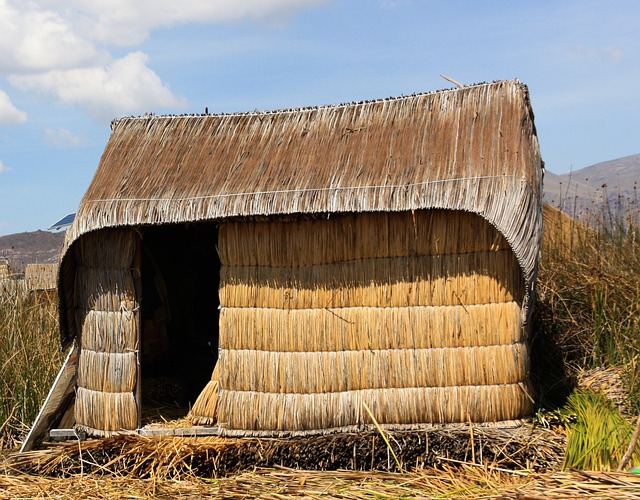
Reed houses on the Uros Islands
Lake Titicaca Legends
Lake Titicaca is extremely significant in terms of local culture. According to Peruvian mythology, Huiracocha, the god of creation, emerged from the lake and created the sun, moon, and stars.
According to Incan lore, this is where Manco Capac, the first Incan King, was born. Legend has it that he was sent down to Earth by the sun.
There have long been rumors of a lost city in the depths of Titicaca. Amazingly, this was proven true by the discovery of a submerged temple in 2000 . Part of a road as well as other buildings were also discovered on the lake bottom.
Lake Titicaca and its Cultural Heritage
Islanders on Lake Titicaca have beliefs and customs that date back centuries. Their style of crafting also shows strong influences from ancient Andean civilizations.
The community of Taquile ( known as the Taquilinos) is one such example. They are recognized internationally for their fine textile works. Different designs of Chuyo hats, bags, and belts represent a person’s relationship status. These items are an important symbol of the Taquilinos culture.
Descendants of an ancient people, the Uros, still live on floating reed islands . Islanders on Aymara practice the same farming methods of growing barley, quinoa and potatoes.
- Combined Uros and Taquile Island Day Tour (leaves from Puno)
Is Lake Titicaca Worth Visiting?
In short, yes. There are not many places where you have the opportunity to see a lake of this scale in South America. On top of that, the island communities are something completely unique.
To be honest, Lake Titicaca tours are very ‘foreigner curated’. Don’t let this put you off though. You can still have a great time for a low price. The Titicaca area is known for its knitting and embroidery work and it's a good place to buy authentic handmade souvenirs.
Overall, Titicaca is worth the trip from one of Peru’s major cities (see more on this below). If nothing else, you’ll have sole bragging rights after seeing the world's highest large lake.
Where Is Lake Titicaca Located?
Lake Titicaca is a huge freshwater lake located in the west of the South American continent, intersecting the borders of Peru and Bolivia. It is convenient to stop at Titicaca en route between these two countries.
There is a narrow channel that separates the lake into two parts - east and west. The Western part of the lake is in Peru’s Puno region and the Eastern Part lies in Bolivia’s La Paz region. In Peru, the smallest part is called Pequeño while it is known as Huinaymarca in Bolivia.
5 major rivers as well as nearly 20 smaller tributaries feed into Lake Titicaca. It is 190km (120 miles) long and 80km (50 miles) at its widest. The surface area of Lake Titicaca is 8,300km² (3,200 square miles).
How To Get From Cusco To Lake Titicaca?
From Cusco, it is most practical to head to Puno to access Lake Titicaca. I will provide more details on getting to Puno from Cusco below.
Fly From Cusco To Puno
The fastest way to get from Cusco to Puno is by plane, which is a one-hour flight. LATAM and SKY Airlines currently offer this route with one-way tickets costing $60 and up.
Please Note: Juliaca Airport is about 44km (27 miles) outside of Puno. You will need to take a taxi to the airport or a transfer from your accommodation near the lake.
Cusco-Puno By Bus
The cheapest way to get to Lake Titicaca is by bus from Cusco or Arequipa. Several companies offer this route during the day and as a sleeper bus. Travel time by bus from Cusco to Lake Titicaca (Puno) is between 8-9 hours.
The cost of bus tickets from Cusco to Puno start from about 40 soles / $10. I recommend shelling out a bit extra and traveling with a good bus company. In my humble opinion, Cruz Del Sur is the most comfortable and reliable operator offering this route.
Cusco-Arequipa-Puno By Bus
If you have the time and budget, I’d recommend taking a detour and spending a few days at Arequipa. This beautiful city has a calm atmosphere and gives you a good opportunity to catch your breath. If you need more adrenaline, raft down rapids or trek up a volcano (see what to do in Arequipa ).
The travel time from Cusco to Arequipa is around 8 hours. I was very happy with the Oltursa bus service for this route. For 49 soles ($12), they included water and a snack.
From Arequipa, you can take another overnight bus with Cruz Del Sur to Puno (which costs about 55 soles / $14).
You Arrive In Puno Before 6 am, Now What?
If you take an overnight bus, you will arrive very early in Puno. I highly recommend heading to Ricos Pan from here. This is one of the very few cafes in Peru that is open at 6 am. The restaurant has strong WiFi connectivity, good coffee, and wholesome breakfast options. They also serve the best baked cheesecake in the country.
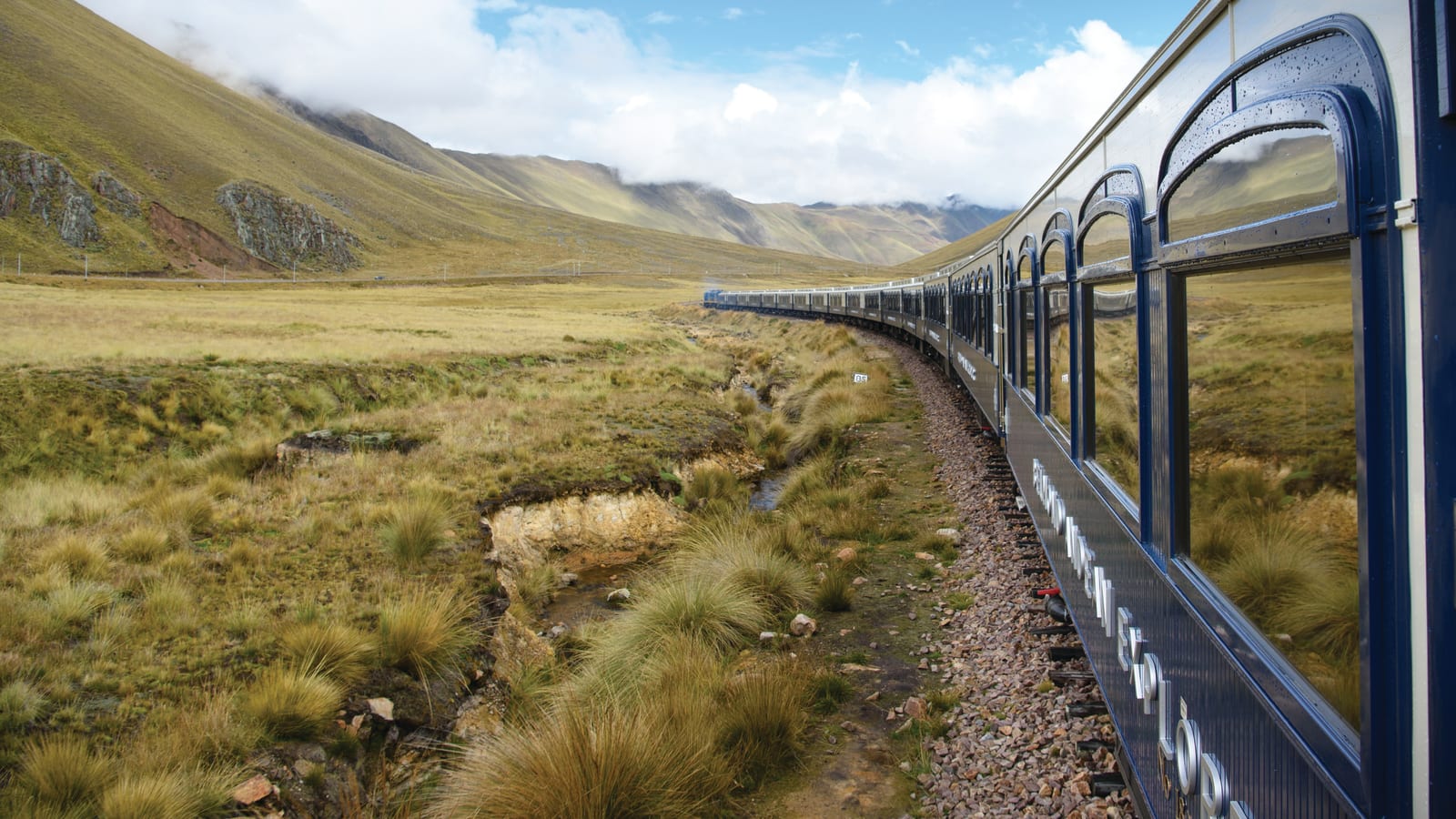
Cusco-Puno route on the Belmond Andean Explorer luxury train
Cusco to Puno By Train - Travel to Lake Titicaca in Luxury
Looking for something different? You can also get to LakeTiticaca by rail. PeruRail runs a touristic train route between Cusco and Puno, which takes 10.5 hours. This route is available every day except Tuesdays.
This is a slightly longer way to get to Titicaca, but you will be riding in style the whole way! This luxury train ride includes gourmet meals and onboard entertainment. Tickets go for around $400 for a return trip.
There is an even more luxurious train option than this. The Belmond Andean Explorer also has a Cusco-Puno-Cusco route. With private sleeper cabins and inclusive cocktails, this is a 5-star hotel on wheels. Be ready to shell out about $1,200 per person for a one way ticket.
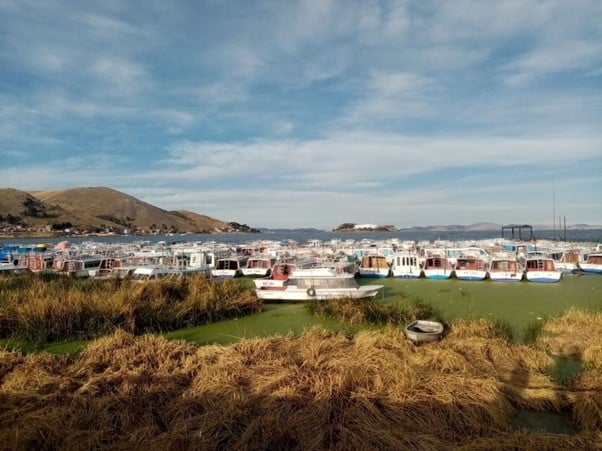
Puno harbor
Visiting Lake Titicaca In Peru
Puno is the most convenient town from which to access Lake Titicaca.
There is an Airport at Puno with daily flights to and from Lima and Arequipa.
Most people only allocate enough time to Puno to visit the lake itself. If you have some time, this small town is worth an extra day. From Puno, you can take a day trip to the floating islands of Uros . You can also visit Taquile and Amnatani from here.
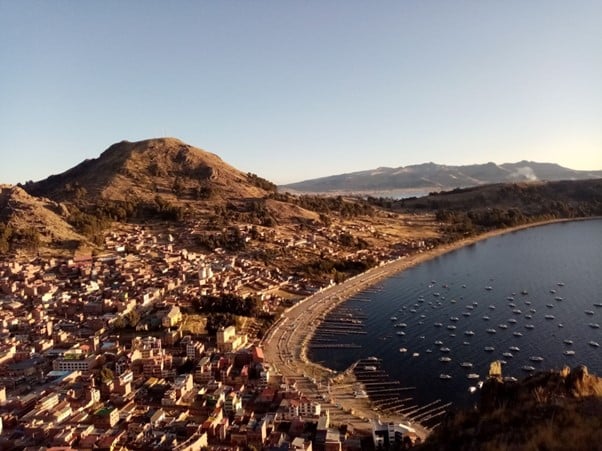
Visiting Lake Titicaca In Bolivia
If you are traveling from Bolivia to Puno, you may want to make a stop at Copacabana. This is a convenient town to spend a day or two in and visit the lake.
You can take a day trip or stay overnight on Isla del Sol. Boats run twice a day at 8:30 am and 1:30 pm, returning at 3:30 pm and 5 pm. Here, you can see the Chinkana Labyrinth , believed to be a training center for spiritual leaders.
What Is There To See On Lake Titicaca?
There are several things worth seeing while visiting Lake Titicaca .
Visit Titicaca’s Islands
Titicaca is most famous for its floating reed islands, known as the Islas Uros (Uros Islands). The floating islands are easily accessible from the coastal town of Puno. There are currently about 100 of these islands and they are multiplying as the islanders’ families expand.
You can visit the floating islands as a day trip or as part of a multi-island tour from Puno. If you opt for a multi-island tour, you will likely also visit Taquile. This is one of a handful of permanent islands on Lake Titicaca.
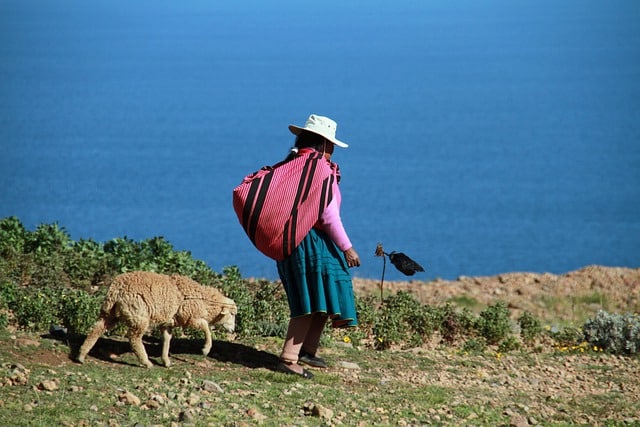
Floating islands of Uros
Spend time with an Island Family
If you enjoy more immersive experiences, you can spend the night on an Island in a village home. This is a great way to experience daily life and traditions within Lake Titicaca’s farming communities.
If you want to find out what it’s like to spend the night on one of Titicaca’s islands, you can read my personal account of an island homestay.
Ruins around Lake Titicaca
There are plenty of land-based ruins to see around Lake Titicaca. Whether in Puno or Copacabana, many ruin sites are easily accessible to visitors. Some of the Titicaca ruins even pre-date the Incan empire.
- Ruins on the Inca trail
- Inca trail facts
Lake Titicaca is superb for birdwatching. There are hundreds of different waterfowl who live in this aquatic habitat. Look out for Puno Ibis, flightless grebe, and Chilean pink flamingos.
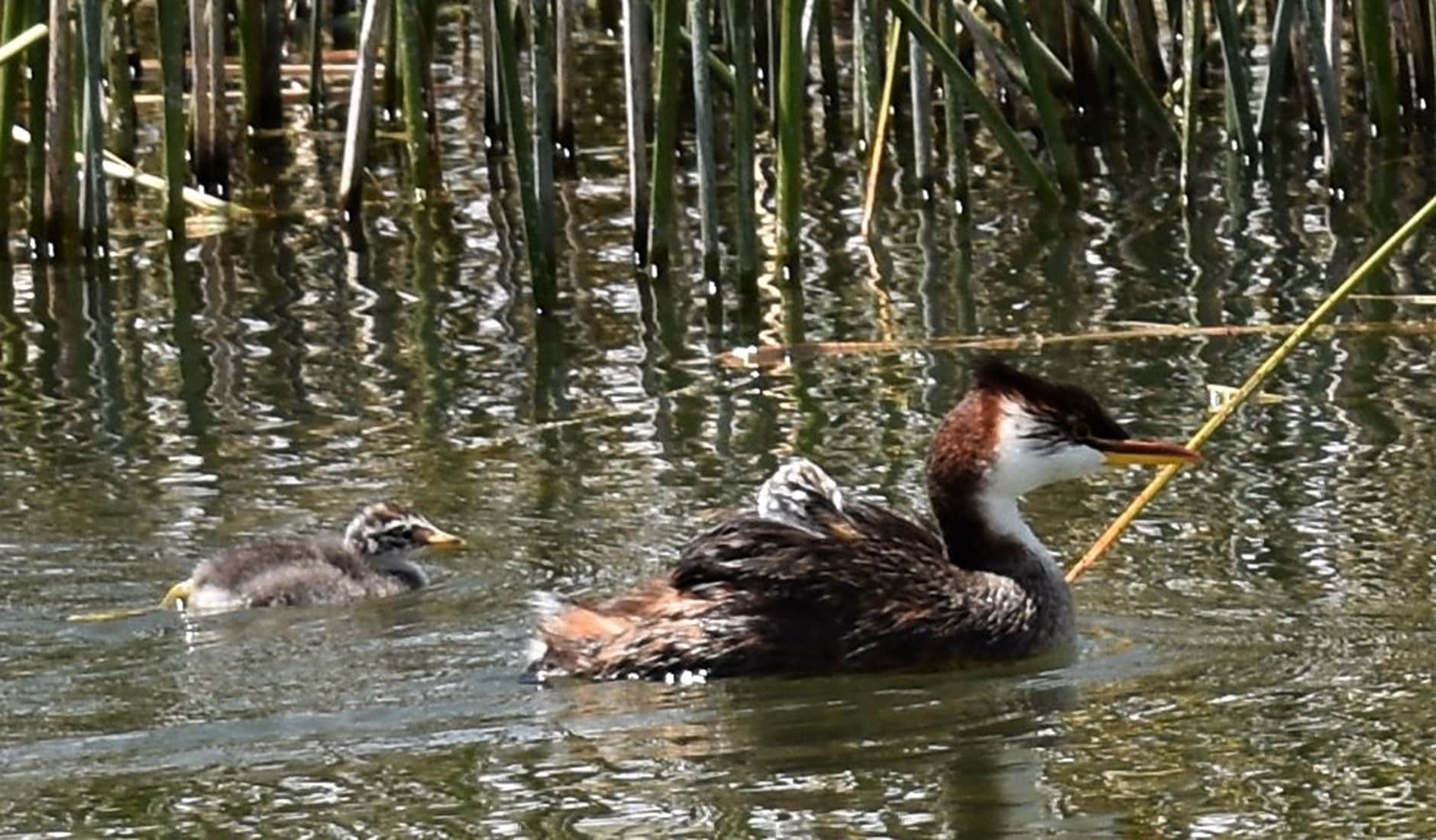
A grebe with chicks on Lake Titicaca
Can you swim in Lake Titicaca?
Technically, you can swim in Lake Titicaca. It's a huge lake and no one is going to stop you from wading in.
Before you pack your swimsuit though, know that you probably won't want to take a dip in Lake Titicaca. The water is uncomfortably cold. If you are determined to swim, brace yourself for temperatures between 10-14°C (50- 57°F).
Also, be aware that there is quite a bit of water pollution from the nearby towns.
The water in Lake Titicaca is slightly brackish too, its salinity ranging from 5.2-5.5 parts per 1000.
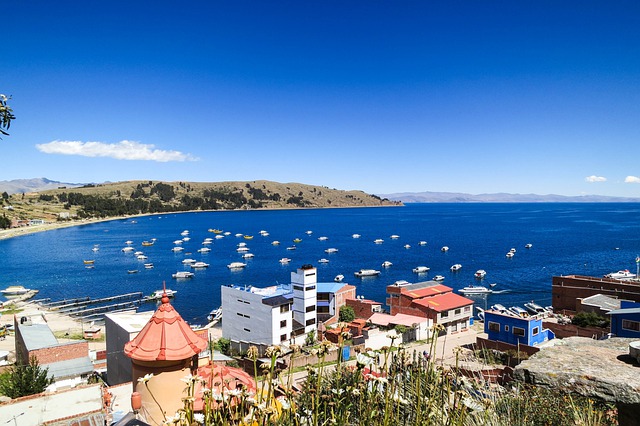
Copacabana section of Lake Titicaca
Best Time To Visit Lake Titicaca
Winter (May-October) is very dry, making it the best time to visit Lake Titicaca. During this time, the days are pleasant and mild. Be sure to pack warm clothing as evenings get icy cold.
If you want to catch the Festival de la Virgen de la Candelaria , visit Titicaca in the first two weeks of February. This is the biggest festival of the year and is celebrated in both Puno and Copacabana.
The shoulder season months of April and October offer a good balance. Chances are good for decent weather during these months. Plus, tours and accommodation are usually discounted.
On average, the lake receives 600mm of rain a year, most of which falls during thunderstorms in the summer (December-March). This is not the ideal time to be hiking around the islands.
Where To Stay On Lake Titicaca
Where you stay around Lake Titicaca depends on your budget. There is a selection of hostels as well as fancier hotels to choose from. This applies to both the Peruvian and Bolivian sides of Lake Titicaca.
Read on for more reviews and recommendations of Lake Titicaca Hotels .
Alison Macallister
With a degree in Nature Conservation and experience working with wildlife including the Big 5, Alison works as a guide for a 5-star reserve. She enjoys sharing her passion for all things nature-related. She enjoys hiking, horseriding, 4x4 driving and kayaking.
Leave a Reply
Your email address will not be published. Required fields are marked
Name * * * *
Email * * * *
Get a quote from our recommended local trek operator in Peru
Ask me any questions you have.
Get your Machu Picchu questions answered.
Join my Free Facebook Group
Get a Machu Picchu trek quote
Best Local Guides. Great Value Hikes.
- Just Me
- Me + 1
- Me + 2
- Me + 3
- Me + 4
- Me + 5
- More than 6
The Best Places to See When Visiting Lake Titicaca

Disclosure: This post (probably) contains affiliate links. If you click on one, I may make a small commission. Of course, this will come at no extra cost to you and helps keep this site running.
Visit the likes of Bolivia and Peru and much of the attention is drawn to hiking in the Andes Mountains . Sure visiting places like Machu Picchu and the Inca Trail is fantastic but tourists also have a great time visiting Lake Titicaca . Deep in the highlands of the Andes in South America, this lake spans across the border between Peru and Bolivia . It also happens to be the highest navigable body of water in the world, which incidentally, seems to make it a popular trivia question.
Anyway, on both the Bolivian and Peruvian sides, there are some great destinations to visit. Some are found on the shores of the lake, while other must-see destinations are actually found on the lake itself. What’s great is that Lake Titicaca manages to combine deep historical and cultural significance with some beautiful raw scenery.
I know from my time travelling around here in 2015, there was plenty more here than I ever would have expected. Each of these places offers a different balance of these elements and feel wholly different from one another. Plus, there’s the modern divide between places on Lake Titicaca in Bolivia and in Peru . So with all that in mind, here are the best places to see as you’re visiting Lake Titicaca.
Table of Contents
Uros Islands, Peru

Perhaps the most famous of the Lake Titicaca attractions has to be the Uros Islands just off its western end. Better known as the Lake Titicaca floating islands, these man-made islands are constructed from floating reed plants roped together. This is quite a complex and continuous process to ensure the stability of the islands, but their indigenous residents are up to the task. Safe to say, you’ve unlikely seen anything quite like them.
There’s many things fascinating about the Uros Islands, from how they’re constructed to the lifestyle that this environment demands. Even just how these low-lying islands seem to appear out of nowhere as you first arrive is a surprise. Once reached from the mainland, visitors are shown about the reed islands and see how the local Uru people live. Walking about, it’s hard to get accustomed to the way the island’s reeds gently sink beneath your feet.

Surviving mostly on tourism in this day and age, the Uru people sell various hand crafted products to tourists. They also offer rides in magnificent reed boats as they gently glide from one island to the next. The Uru people really make the most of this resource and manage to create something special from it. Even if you only visit to admire their ingenuity, it’s worth it.
Getting There: Visiting the Uros Islands on a tour from Puno is the most common way people get out there. But while many only come for the day, some choose to try a local homestay and spend the night on the reed islands.
Copacabana, Bolivia

Sitting just by the Peru border at Lake Titicaca’s eastern end is the coastal town of Copacabana . No, not the famous beach in Brazil, but a humble town with one heck of a view. Much of Copacabana is fairly standard and indistinguishable from any other Bolivian town, but it does have a few features that make it a noteworthy place to visit on Lake Titicaca.
First off is the simple fact that it has a rather pleasant lakefront, with a slight beach and plenty of boats. Then there’s the slightly unexpected hippy vibe that parts of the town has managed to cultivate. This is definitely due to its place on the backpacker route as the first stop for those crossing into Bolivia from Peru. To me it was most felt on Avenida 6 de Agosto , with most of the hostels and foreign restaurants are found.

But the real highlight is the hilltop Calvario that overlooks the lake with some incredible views. Associated with the 16th century Basilica of Our Lady of Copacabana in town, the Calvary is topped by an altar that is very important to the local religious community. It also is quite the tough walk up because of the steep incline and the fact that it sits at 3,841 metres elevation. Thankfully, once you’re at the top you can find somewhere to sit and take in the panoramic view over Copacabana and Lake Titicaca.
Getting There: Take a bus either from Puno in Peru or from La Paz, which also involves a ferry crossing as well. There’s a decent range of accommodation in Copacabana that you can choose from.

Of the many places positioned by Lake Titicaca, few received as mixed a response as the city of Puno . It seems that your personality, company and circumstance play a huge part in whether you enjoy your time here or not. Why then do so many people come here? Basically because Puno is very much a natural stopping point between ever-popular Cusco and La Paz in Bolivia. It also makes for a great setting off point for other destinations around Lake Titicaca and southern Peru as you can see in this article.
As for Puno itself, the city has long been a trading hub for this part of Lake Titicaca, as well as communities in the surrounding region. For tourists to Puno, the best visits seem to coincide with local festivals like Puno Week in early November, as well as Carnaval celebrations.
Everyday attractions in Puno though focus on the city’s historic churches like Puno Cathedral , as well as the panoramic city views from the hilltop miradors . In the end, Puno is typically an essential stop along Lake Titicaca, so make the most of it.

Getting There: Puno is a fairly major travel destination for this corner of Peru. It’s one of the standard stops on many Peru itineraries, whether’s it via Juliaca Airport, the Andean Explorer train or a bus from various major destinations. As such, the choice of where to stay in Puno is one with many options.
Isla del Sol, Bolivia

One of the coolest and most underrated destinations in this corner of South America has to be another of the Lake Titicaca islands – Isla del Sol . A rugged island, it owes its name to the fact that the Incas believed their sun god was born on this island. Home to several small local communities, Isla del Sol is also the site of many well-preserved Inca remains. Essentially, the island is a well-rounded destination, with something for everyone.
Generally, visitors will spend time in either village of Challapampa in the north, Yumani in the south, or both. To properly see both in a day though, requires hiking from one end of the island to the other. A common activity here on Isla del Sol, I rather failed at it when I tried.
This means traversing the hilly and often sparse terrain. Still, once you start to get good views of the island’s scenery, it’s well worth it. Throw in intriguing Inca ruins like the site at Chinkana and the Inca Stairs at Yumani, and it’s safe to say there’s plenty to see.

Only accessible by a slow boat ride, visiting Isla del Sol is a nice day trip from Copacabana. It seems to be quite similar to islands on Peru’s side of the lake, like Taquile island and Amantani island . Still, if you can manage to see more than one island, you won’t regret it.
Getting There: To reach Isla del Sol, take a ferry over from Copacabana. This can mean either a day trip over to the island, camping on the island overnight or finding a local homestay .
Sillustani, Peru

Although not exactly perched on Lake Titicaca, one other sight that surely counts it’s that close is Sillustani . Ruins from a cemetery that has existed before even the Inca, Sillustani is found by Lake Umayo just outside Puno. This historic attraction is easily spotted despite being situated on quite a rural, hilly landscape. That’s thanks to the remaining burial towers called chullpas that stand proudly among piles of scattered stone.
Not all the chullpas have survived all that gracefully, with many collapsed or reconstructed in recent years. That being said, some of the funerary towers still have carvings of animals shown on their side. Considering that many civilizations have inhabited the area since the Aymara people built them, that’s understandable. Today, it seems to be surrounded by farm land, with herds of alpaca nearby.

Then there’s the beautiful scene of Lake Umayo, looking like I imagine a Scottish loch would. The view of the lake really stuck with me, from a lonely fisherman paddling out across it, to Isla Umayo and its sheer cliffs. Hard to think that with a short drive you’re back in the midst of Puno.
Getting There: It’s possible to visit Sillustani with a day trip from Puno. Independent travel, on the other hand, could be quite a challenge.
Visiting Lake Titicaca

Most of these places to see when visiting Lake Titicaca are firmly found on the tourist trail through Peru and Bolivia. That’s good news for travellers, as that means you shouldn’t have too hard a time reaching them. As transport providers have surely changed since I was last there, I won’t be much use in that regard.
Same goes for Lake Titicaca tours, but I will say that booking things locally worked well for me. If you are hoping to book ahead, it’s worth checking out Viator for places like Copacabana as clearly there are some options available. As mentioned earlier, Lake Titicaca also features on a number of longer tours, like those offered by G Adventures . Ultimately though, staying in Puno and Copacabana are your two best bets for visiting most of the things to do in Lake Titicaca’s area.
If you’ve been, where were your favourite places when visiting Lake Titicaca? What are the other best places to see in this part of South America? Should I share more from my time in Latin America? Please share your thoughts in the comments below.
David is the author behind the Travelsewhere travel blog and is always on the search for the quieter, less-visited corners of the world.
You may also like
Off track on isla del sol, bolivia.
It’s always so interesting to read your stories and how honest you are about failing at something. This is a beautiful region I would definitely be willing to get my hiking boots out for! Thanks David for linking up with #TheWeeklyPostcard!
You covered a lot of places! I did Uros and Puno only. #theweeklypostcard
Wow, you made it all the way to South America, David. That’s great! Visiting Peru and Bolivia is very high up on my list, but I was rather thinking about seeing Machu Picchu and other sites. I had no idea Lake Titicaca is so beautiful. Totally worth adding to my bucket list. Thanks for sharing this. #TheWeeklyPostcard
Isla del Sol looks beautiful! That destination would be at the top of my list. I unfortunately did not make it this far south when I was in Peru, but since I have Bolivia on my bucket list, I know where I need to go when I make it there. #TheWeeklyPostcard
Beautiful photos, as always, David. I’m amazed at the size of the reed boat compared to the homes on the island. It’s HUGE. I’m fascinated by the reed islands. Do you know anything about why the Uru people decided to settle there? It seems rather resourceful – but also I would expect it requires quite a bit of upkeep. It might have enhanced stability though if there’s a rainy season… Thanks for sharing – now I have something new to research!
I spent ten days traversing Peru but bowed out before going to Lake Titicaca. The altitude was too difficult for my heart. Still I would love to see those islands and views. Such an interesting part of the world.
Leave a Reply Cancel reply
This site uses Akismet to reduce spam. Learn how your comment data is processed .
Are you sure you want to close the session?
La cuenta ya se encuentra activa
Or enter your e-mail:
Recover your offer
We will send you a 4-digit code shortly
Enter the 4-digit code and your new password
Enter your search here
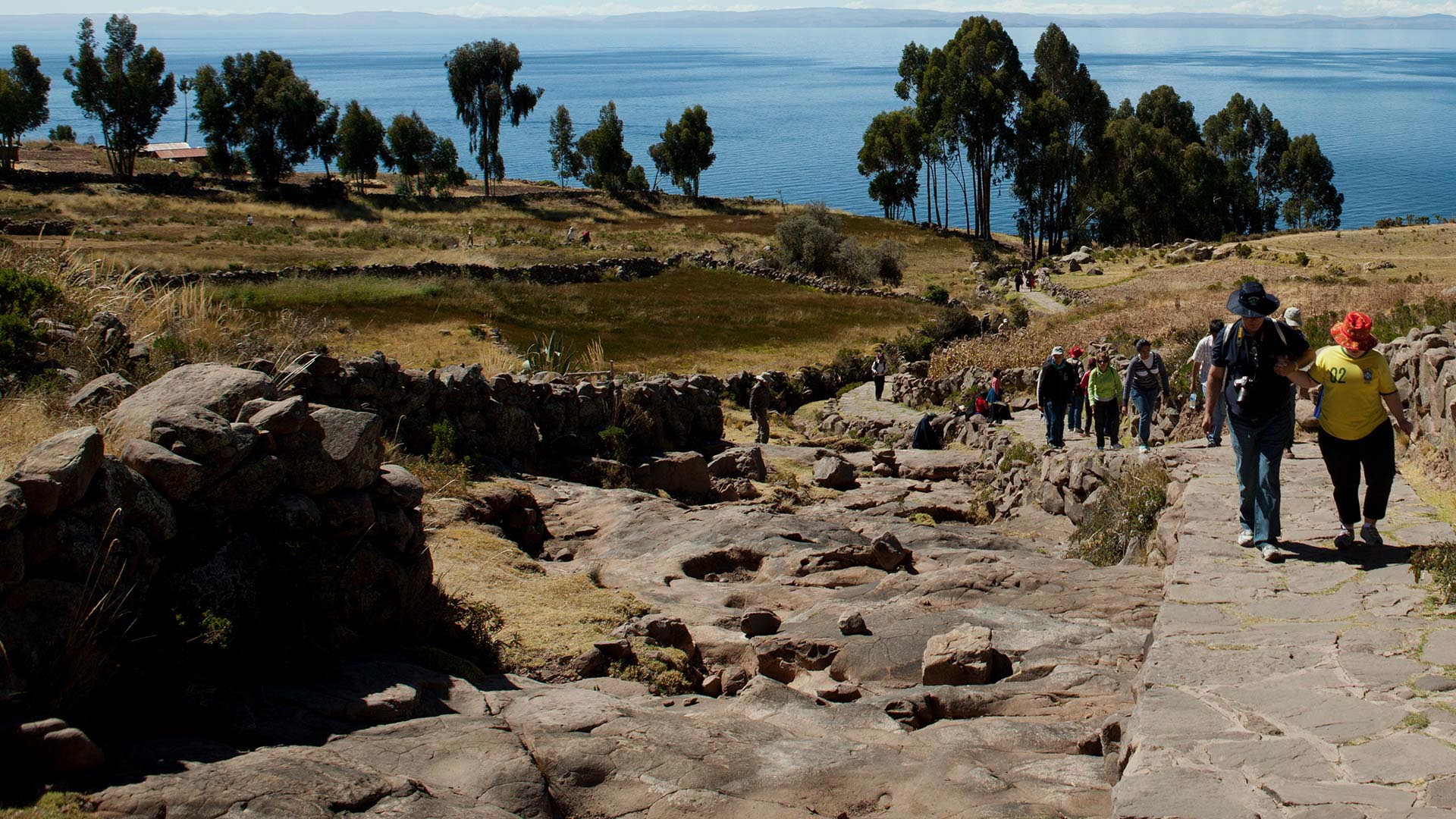
- Visit the islands of Lake Titicaca
Lost in the vastness of the lake
Taquile Island Department of Puno
- Experiences
A sense of vastness, of the infinite, is the feeling one experiences when taking a boat across the waters of Lake Titicaca, in Puno . The lake is so big that you can feel like you’re in the middle of a sea, as you spot islands where customs and traditions have remained unchanged for hundreds of years.
A tour of the lake should include the Uros Islands, made entirely from reeds; Taquile, an island where the weavers have achieved worldwide renown; and Amantani, where it is possible to get away from everything and simply relax.
Here, the sunrise and sunset are indescribable, while the night is filled with stars that appear so close you think that you might almost be able to touch them. The islands of Lake Titicaca offer a magical invitation.
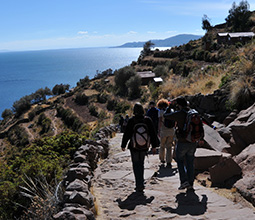
Carretera Longitudinal de la Sierra Sur, Avenida Circunvalación
43.8 km, 50 min.
How to get to this experience?
Lima - Juliaca
By air: 1h 15 min approximately
Juliaca - Puno
By bus or car: 52 min approximately
Lima - Puno
By bus or car: 21 h approximately
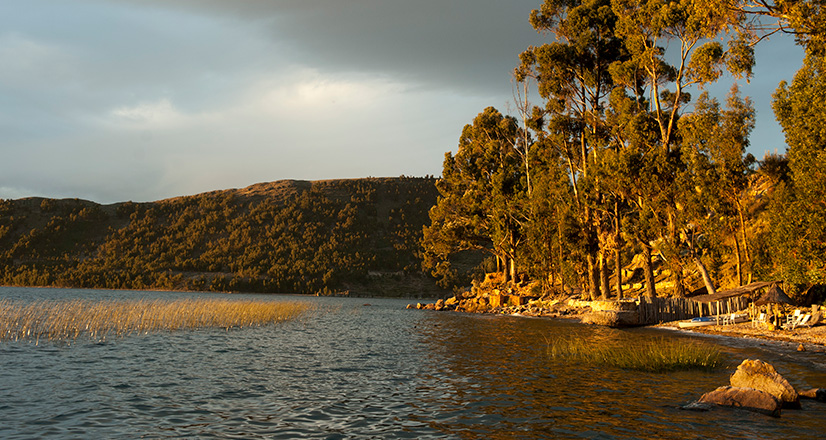
General information
Dependent on the operator
Camera, cash, sunscreen, outdoor sports clothing.
3 825 meters above sea level
Min. 3 ℃ / Max. 14 ℃
Experience the best of Perú
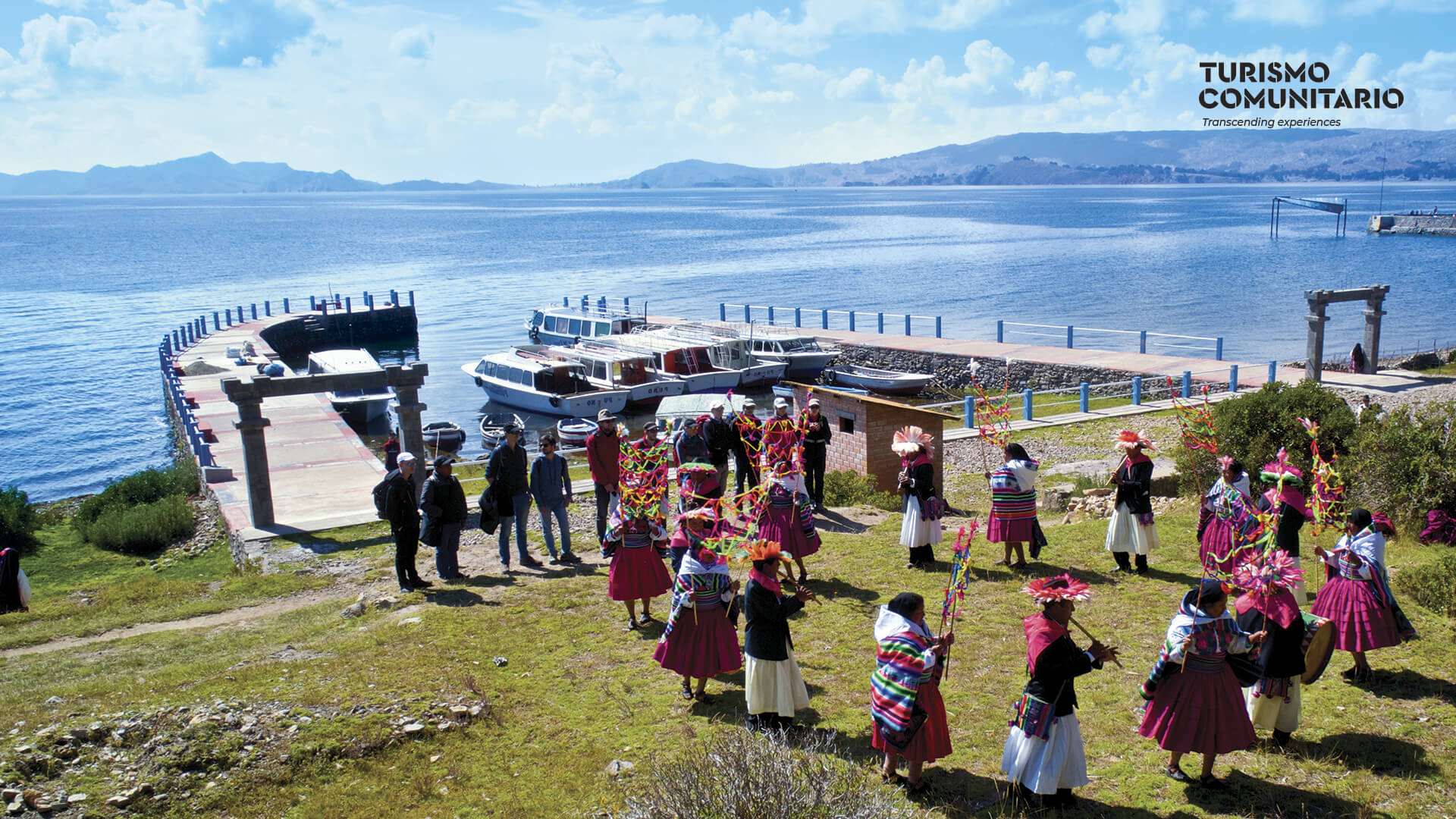
Paradise surrounded by water
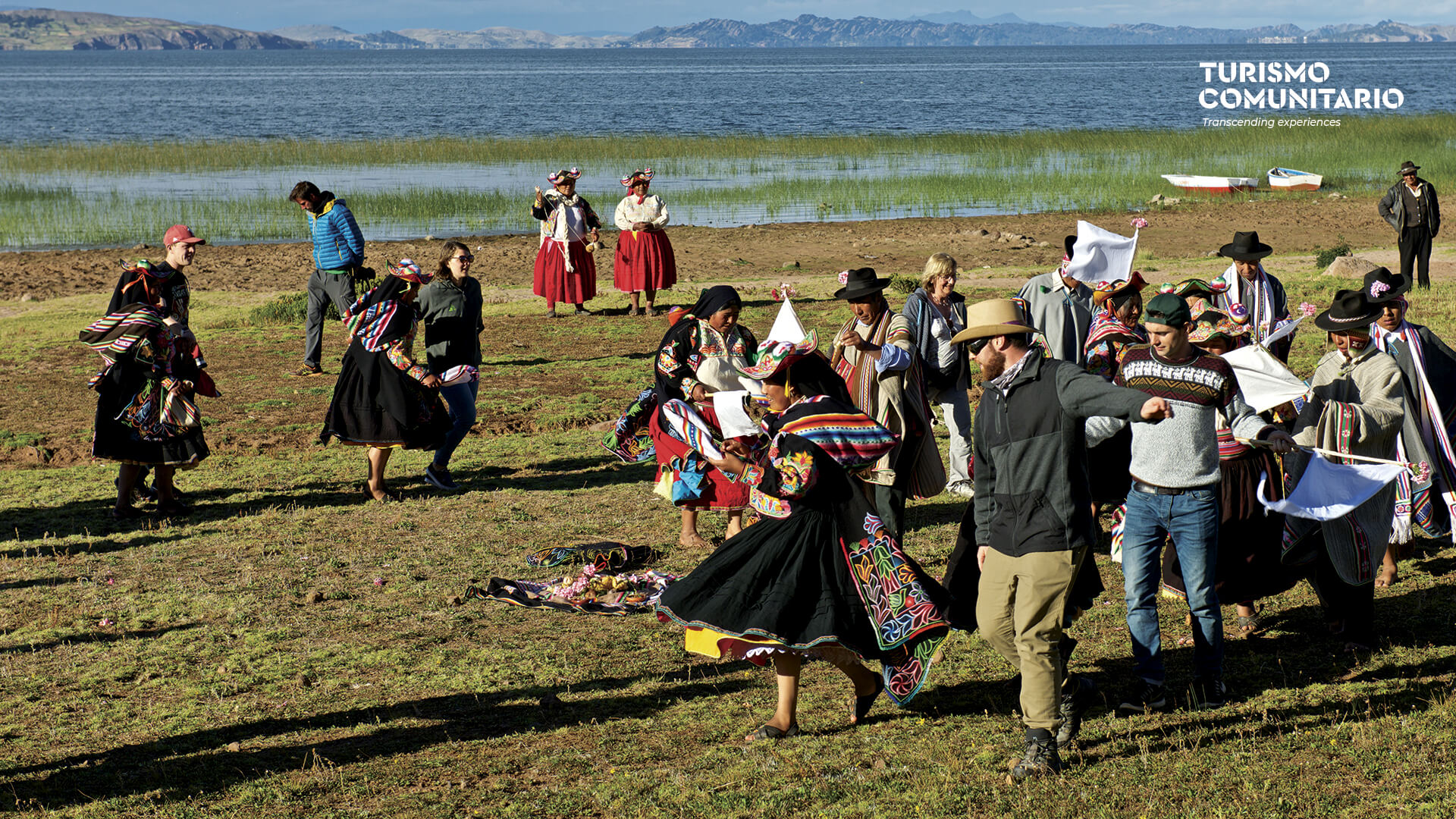
An adventure near the lake
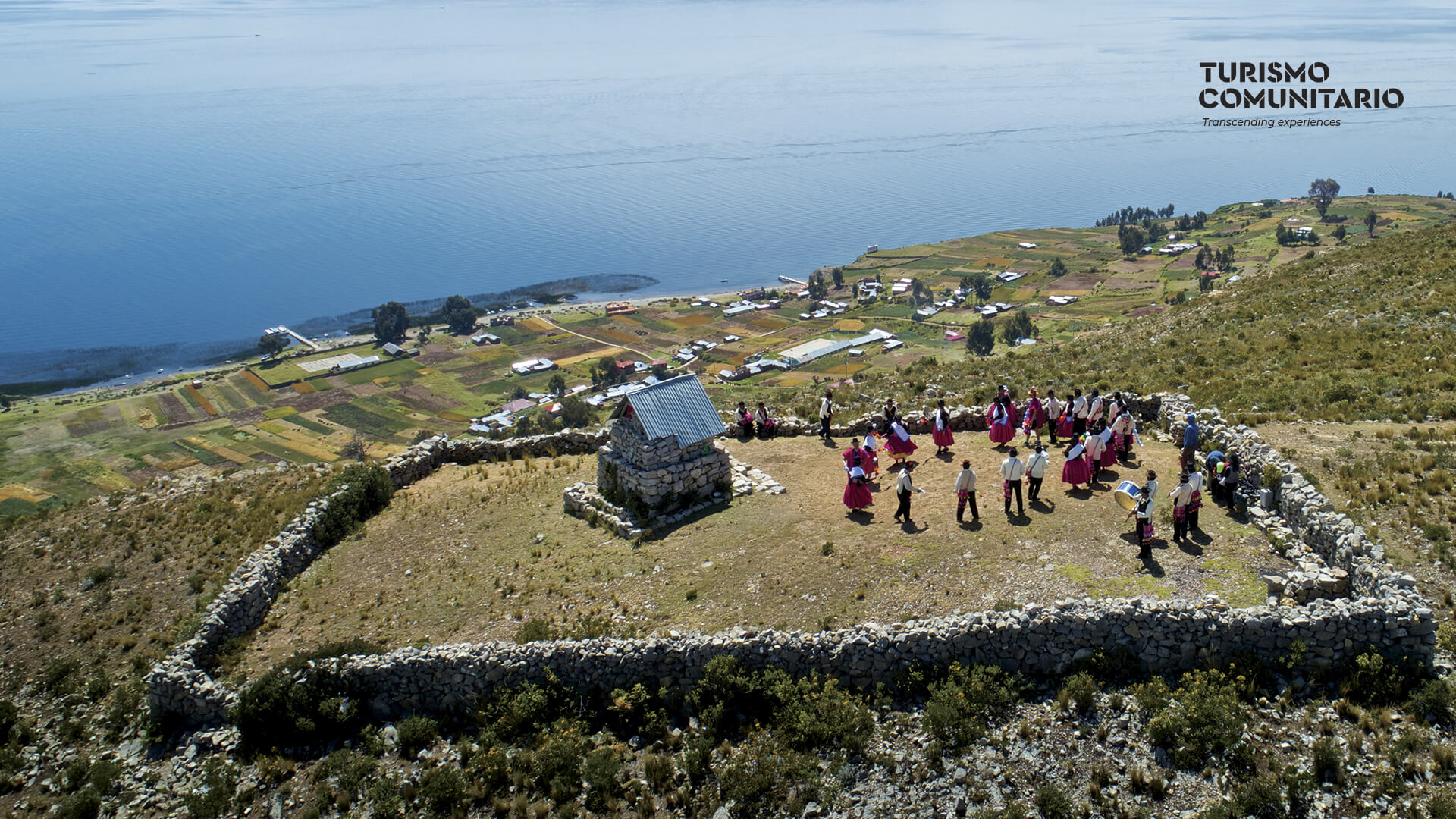
Hidden beauty
We help you plan your trip!
- Why hop with us
- Hop Login Here
- How We Started
- Who Travels with us?
- Why Hop With Us?
- Unique Hop Stops
- Peru Hop vs Public Buses in Peru
- Frequently asked questions
- Guide to Peru
- How It Works
- Tickets & Trips
- Exclusive Hotel/Hostel Discounts
- Group Travel
- Secret Slave Tunnels
- Nazca Lines Viewing Tower
- Paracas National Reserve
- Pisco Vineyard
- Machu Picchu
- Day Trips from Lima
- Day Trips From Cusco
- Day Trips from La Paz
- Paracas Day Trips
- Huacachina Day Tours
- Extra Tours
- Rainbow Mountain
- Ballestas Islands
- Quad Bike ATV
- Paragliding in Paracas
- Buggy and Sandboarding
- Nazca Lines Flight
- Full Day Tour
- Ruta del Sillar Tour
Lake Titicaca
- 2 Hour Tour
- Isla del Sol
Lake Titicaca Tours: 2024 Updated information about Lake Titicaca Tours from how to get there, itineraries, prices, and FAQs!
Lake Titicaca Brief Summary:
- Lake Titicaca Tours are the only way to experience the highest navigable lake in the world at over 3,800 meters above sea level!
- Lake Titicaca Tours start in Puno, the gateway to launch a visit out to the famous Floating Reed Islands of the Uros people.
- The Floating Reed Islands are made entirely of Totora reed, on which the Uros people have managed to forge a subsistence lifestyle for centuries.
- Lake Titicaca Tours can be done in half a day, 1 day or overnight 2-day tours
- How to get to Puno: Fly to Juliaca Airport (1 hour away from Puno) or use Peru Hop bus.
Lake Titicaca Tours, What Are Your Choices?
- 2-Hour Tour – This tour will allow you to visit the famous floating islands of Uros if you’re on a short time limit.
- Full Day – The best way to see the Amantani Island, as well as the floating islands!
- Homestay Tour – Visit the mysterious floating Uros Islands, Amantani Island and Llanchon Peninsula. Spend the night on the islands and live like a local!
Since we know everyone’s needs are different and people like to explore the Lake and its islands in different ways, we have put together a comparison table below of short, full day and 2 day tours. Choose the option that best fits your style and timeframes and go explore.
Peru Hop does not operate any tours on Lake Titicaca. To see Peru Hop’s recommended operators, check out our tips for the 2 Hour , Full Day , and Homestay Tours .
If you are looking for more information about Lake Titicaca Tours, visit FindLocalTrips.com where you can compare itineraries, operators and prices.
Lake Titicaca Guide Contents:
- How to get to Lake Titicaca – Compare transportation options.
- Did you know? – Lake Titicaca fun facts.
- What to bring out on Lake Titicaca? – Be prepared for your tour.
- Titicaca FAQs – We answer your frequently asked questions.
- Photo Gallery – A few of the best photos of Lake Titicaca.
Peru Hop Day Trip!
Voted #1 thing to do in Lima
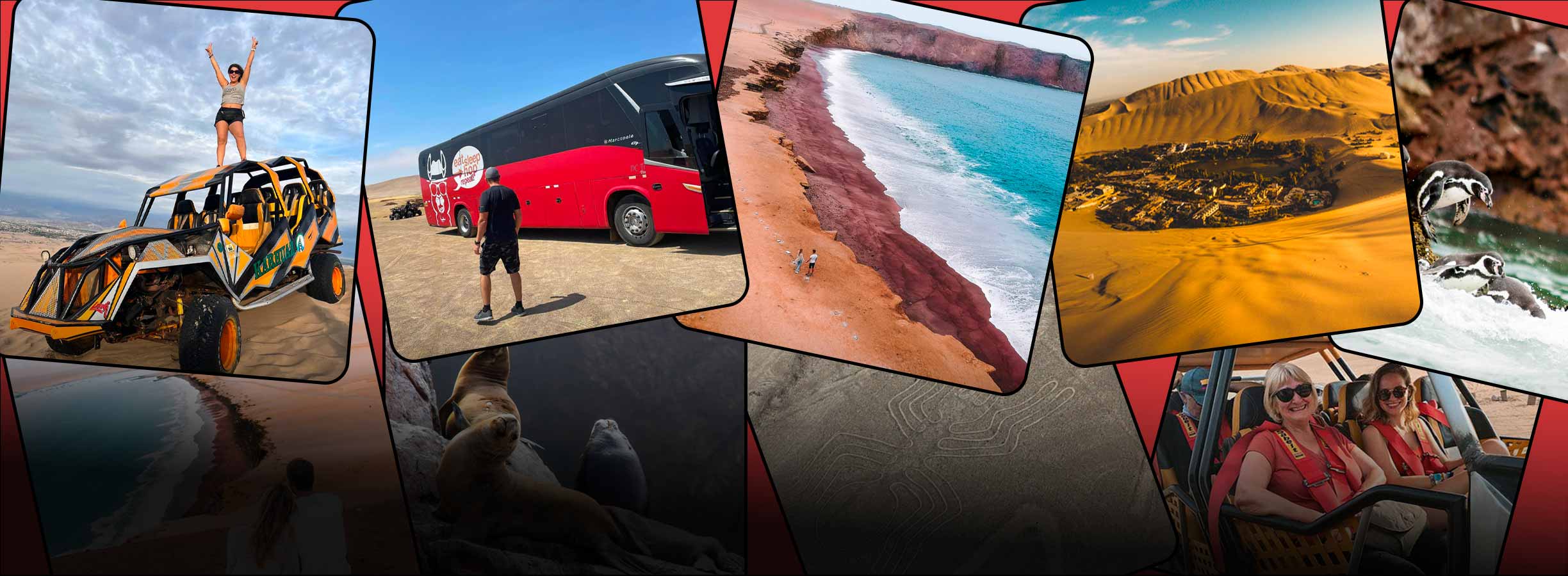
Peru Hop voted #1 thing to do in Lima!
How to get to Lake Titicaca
Lake Titicaca lies on the border between Peru and Bolivia. On the Peruvian shore sits the city of Puno, while on the Bolivian side lies Copacabana.
If you are looking for information on the best buses to take to Puno or Copacabana, visit our passes page. Select your departure city, the countries you want to visit, and amount of time you have to travel. Then browse our passes to see which include your desired stop in Puno or Copacabana.
Did you know?
- Lake Titicaca is the world’s highest navigable lake at over 3800m above sea level!
- The locals speak their own local language on the islands (not Spanish or Quechua).
- The island of Amantani is so remote that they were used as high security prison islands during the Spanish Rule in Peru.
- Over 25 rivers flow into Lake Titicaca.
- 56% of the area of the Lake belongs to Peru and 44% belongs to Bolivia.
- According to Inca legend the principal God, Inti (the Sun God), lived on one of the islands on the Bolivia side of the lake, Isla Del Sol (Island of the Sun). Here, he created his son and daughter, Manco Capac and Mama Ocllo, the very first Incas who later travelled North to found Cusco at the heart of what would become the Inca Empire!
What to bring?
We want you to be well prepared for your tour of the lake.
- Small backpack
- Sunscreen – Very important
- Hat, sunglasses.
- Warm layers, sweater or jacket (IMPORTANT) –Temperatures reach lows of -10 ̊ C.
- Basics like toilet paper, etc
- Personal medications (if necessary)
- Money for drinks
- If doing the Homestay Tour, bring a small overnight bag and toiletries
Titicaca FAQs
I have heard that the Floating Islands are very touristy and fake. Do the Uros people actually live on the islands and are they worth the visit?
The Floating Islands in Puno are the original authentic floating Islands. Due to their unique nature, they have become a very popular tourist attraction in Peru and have become almost a victim of their own success. A visit is still definitely worthwhile to learn about the incredible construction of these islands (houses, boats are all made of reed), and how the Uros people manage to forge a life out in the middle of Lake Titicaca on these tiny buoyant islands. Tourism is now the number one income and whilst families do live out on the islands a lot of the families and younger members do work and study in Puno.
Do the tour prices include the island entry fees? Do I need to take extra money?
Yes, all of the tour prices include the associated island entry fees. Please review the tour table above to see which meals are included if applicable. If heading to the islands of Uros and Amantani , we advise to take some money for souvenirs as they are renowned for some of the finest woven goods in Peru.
I will not be staying the night in Puno. Do I need to take my bags with me on the tour? What should I select as my pick up location?
In Puno, we work with the hostel, Lucky Your House – Titicaca 144. They offer our passengers a free bag storage service and a cheap price for shower use. You can leave your bags at the hostel whilst you do your tour and select this as your pick up location from Puno for the evening departure. It is a couple of blocks from the main plaza – Plaza de Armas.
Can I leave to do the Lake Titicaca Full Day Tour or 2-Day Homestay the same day as I arrive into Puno at 13:00pm?
Unfortunately, this is not possible. The 2-day Homestay and the Full Day tours start everyday early in the morning as the islands themselves are more than 3 hours in boat across the Lake from the city of Puno. You can spend the afternoon visiting the city of Puno, spend the night there and leave for the islands early the next day. Similarly it is not possible to come back from the Islands very early the next morning, there are no boats, the schedule of boats if fixed for these tours.
You May Like
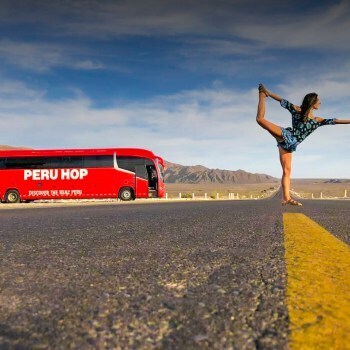
Why Peru Hop Is Being Celebrated For Its COVID Protocols

Everything to Know to Avoid the Typical Tourist Mistakes At Machu Picchu
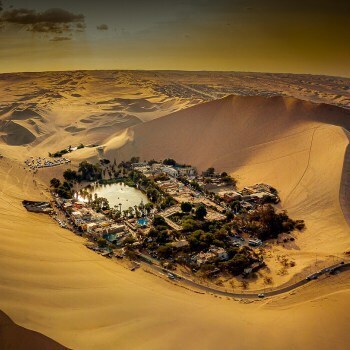
The #1 Thing to Do in Lima – Desert Oasis

PERU INSIDER – Top Travel Tips in 2024
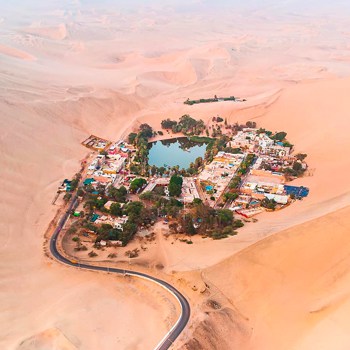
#1 Rated Day Trips From Lima To Unforgettable Destinations

Machu Picchu Tickets – All You Need To Know!
Peru 2024 Travel Updates – All You Need to Know
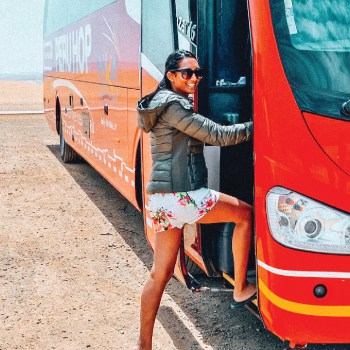
OFFICIAL: View #1 Travel Company in Peru by Tripadvisor
Thank you for your message!
Speak to someone from our team by phone, receive help and advice about queries that you have..
Error: Contact form not found.
Peruvian time now is: 5:17 pm
Attractions
Things to see around lake titicaca.
Day trips to the Island of Sun are serviced by large catamaran boats. A full-day trip with lunch and transfers costs $268.
If you stay there overnight, you will enjoy the party that is organized there every night. You will get traditional dresses, and local people will help you learn their traditional dance.
Isla de la Luna has a mythological significance to the Incas, and you can find here the ruins of the Temple of the Virgins. There are only 80 amicable people living here, and thereby it’s tranquil and peaceful.
It takes about 3 hours by bus to reach Copacabana from the Bolivian capital city, La Paz. First thing first, take a 30-minute long climb to Cerro Calvario. It has a fantastic view of the town, the lake, and the mountains.
Copacabana Cathedral is a must-see too. It was completed in 1619, and it’s one of the oldest churches in Bolivia and is a fine example of Moorish-style architecture. Museo del Poncho is showcasing the clothing of the Andean Community, and entry costs Bs 15 (around 2 USD).
Copacabana is perfect for enjoying slow life. Like drinking coffee with the majestic Lake Titicaca views or laying in a hammock in one of the hillside “ hostals ” offering a breathtaking panorama of the surroundings.
The town is small, so you won’t need a car to get around, and boats, organized or privately hired, can easily get to the port to visit all the small islands.
Click to see our selection of the most amazing hotels on Lake Titicaca
- Beauty Demo
- General Demo
- Magazine Demo
- Trendy Demo
- Bold Blog Demo
- Explore All
- Stylish Dark
- Alternate Light
- Light Without Widgets
- Dark With Widgets
- Dark Without Widgets
- Classic / Magazine
- Stylish Dark Alt
- Classic Post
- Creative Large
- Modern Overlay
- Dynamic Full Width
- Magazine Post
- Classic Full Width
- Without Featured Image
- Audio Post Format
- Video Post Format
- Gallery Slider Format
- Stylish Slider
- Beauty Slider
- Classic Slider
- Bold Large Slider
- Full Width Slider
- Trendy Slider
- Grid Slider
- Tall Grid Slider
- Carousel Slider
- Standard Page
- Full Width Page
- First Large Then Grid
- Overlay Then Grid
- First Large Then List
- Overlay Then List
- Mixed Large Then Grid
- Mixed Overlay Then Grid
- Classic Style
- Special Gallery
- Tiled Mosaic
- Thumbnail Grid
- Rounded Images
- Square Tiles
- Disable Sticky Bar
- Tag Archive
- Date Archive
- Search Results
- Author Archive
Type above and press Enter to search. Press Esc to cancel.

4 Tips For Visiting South America’s Lake Titicaca
A s the world’s highest navigable lake and the largest in South America, Lake Titicaca is more than just fun to say. At 12,500 feet above sea level and tucked in the Andes Mountains, Lake Titicaca is surrounded by both Bolivia and Peru. Each side offers their own unique experiences.
From above, its shape resembles a puma chasing a rabbit and it is this that gave the lake its name, Titi Khar’ka , which means “rock of the puma” in the local Indigenous language of Aymara. There are over 40 islands, many of which are inhabited, some of which float.
If you are visiting either Bolivia or Peru, be sure to make Lake Titicaca a stop on your itinerary. I was lucky enough to visit both sides on separate trips. Here I will share my best tips for visiting and enjoying Lake Titicaca.
1. Be Aware Of The Altitude
I live in Colorado and foolishly thought I might be immune to the effects of the altitude. However, the lake is over twice as high as the Mile High City of Denver and I felt it. Altitude sickness is real and should be taken seriously when visiting Lake Titicaca. If you find that you are feeling dizzy, tired, experiencing shortness of breath, or have headaches while visiting the lake, that’s altitude sickness.
If you plan to do anything strenuous, it is best to give yourself a day or two to acclimate to the altitude before embarking on any hiking or other adventures. Other tips for adjusting to the altitude include being sure to stay hydrated by drinking plenty of water. As well, refrain from drinking alcohol or smoking as these just exacerbate the problem.
If you’re feeling adventurous, you could try the locals’ remedy of coca leaves. You can find these anywhere in towns near the lake. You can either chew on them or put them in a tea to drink. They come from a medicinal plant in the Andes known to help ease altitude sickness and aid with acclimatization.
2. Visit Isla Del Sol
If you are visiting the Bolivian side, you will most likely be in Copacabana (another fun one to say). From there, you can take any number of tours to visit the largest of the 40-plus islands on the lake, Isla del Sol. There are both half-day and full-day trips, as well as overnight trips to choose from.
Tour boats depart from Copacabana and take about 2 hours to reach the island. The boat will pick you up from the same location it dropped you off. There are several things to do and sites to see on the island. What you do there will depend on how much time you have.
I opted for the full-day tour and it allowed me to hike around the entire island. It takes about 3 hours and is incredibly scenic. You will pass the archaeological site of Palacio del Inca, which is a labyrinth of walls and tiny doors. You might also spot a few llamas or farmers since this island is inhabited.
Pro Tips: Isla Del Sol
The island has no cars and is only traversed on foot or by renting a donkey. This is part of the reason people choose to stay overnight or even longer. There is a tranquility on the island that the mainland does not offer.
Bring your swimsuit. Depending on how long you stay, it is possible to take a plunge in the lake. On the north side of the island, there is a beach. On hot days, this is the perfect way to cool down and truly enjoy the lake.
3. Eat Trucha
Perhaps surprisingly, Lake Titicaca is teeming with trout. Apparently in the 1940s, rainbow trout and brown trout were introduced to the lake to improve commercial fishing. A visit to Lake Titicaca is not complete without a proper meal of this lake fish.
Find one of the many lakefront restaurants with an outside deck in Copacabana, order a plate of trucha and a Pacena beer, sit back, and enjoy the happenings on the lake. A typical plate of trucha will come with a small salad, rice, and fried potatoes.
Do not be surprised when the fish comes to you and is pink instead of white on the inside. I can’t tell you how long I spent trying to understand why trucha in Spanish meant “salmon” and not “trout.” Well, it doesn’t. Turns out, even though I’d only ever had trout that had white flesh, trucha from Lake Titicaca has pink flesh similar to salmon.
Also, do not be surprised if it is served to you with its head on and bones in. This is how most fish in South America is served. It is either grilled or fried and it’s absolutely delicious.
4. Visit The Uros Floating Villages
I saved the best and coolest for last. The floating villages were truly a highlight of my first visit to Lake Titicaca and an experience I still think of often today. I had never seen anything like this before — how can islands float?
Believed to be the descendants of some of the earliest inhabitants of Lake Titicaca, the Uros people have kept a floating lifestyle for hundreds of years. Using the endemic tortora plant, they build mobile islands to move from danger when needed.
The Uros now depend heavily on tourism and welcome visitors with smiles. They are eager to show you their way of life and will give demonstrations on how the islands are made.
To visit the floating villages, you will have to be on the Peruvian side. Half-day tours depart from the town of Puno three times a day. Once on the floating islands, you can see first hand just how the tortora plant is weaved (nearly constantly) to make the floating islands, as well as boats and homes in the village.
It was really a wonder to step foot on these floating islands and see the village life of those who inhabit them. Plenty of souvenirs are on offer, all made from the tortora plant.
There is so much to see and do in the areas surrounding Lake Titicaca. You will first have to decide which country you want to visit from. Or like me, you could choose to do both. Either way, be prepared for the high altitude, bring lots of sunscreen and comfortable shoes, and have an adventurous spirit.
Related Reading:
- My 8 Favorite Beach Towns To Visit In Central And South America
- The 5 Best National Parks In South America’s Patagonia Region
- 4 Best Experiences In The Patagonia Region Of Argentina
This article originally appeared on TravelAwaits
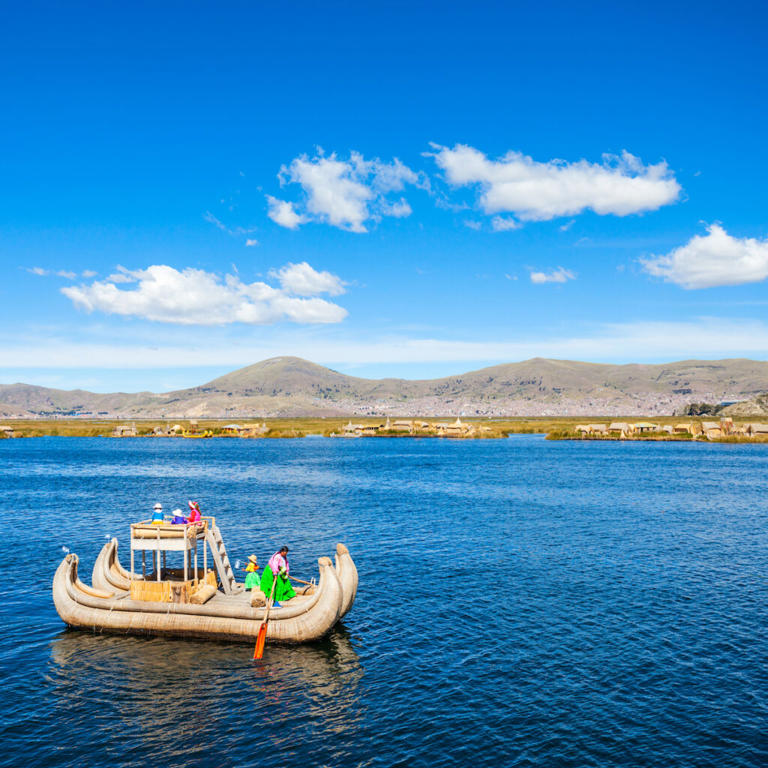

Lake Titicaca Tours
Situated on the border between Peru and Bolivia, the surreal beauty and historical heritage of Lake Titicaca make it one of South America’s most rewarding destinations. Ancient civilizations thrived on the shores and islands of this high elevation lake for thousands of years. Today, its mystical waters are home to diverse Andean communities that you can engage with during one of our Lake Titicaca tours.
Fully Customizable
Personalized service, handpicked hotels, 5000 + testimonials, the 7 best lake titicaca for 2024/2025, our team strives for the utmost quality, comfort, and great value for all of our travelers. get started customizing your trip with an expert travel advisor..
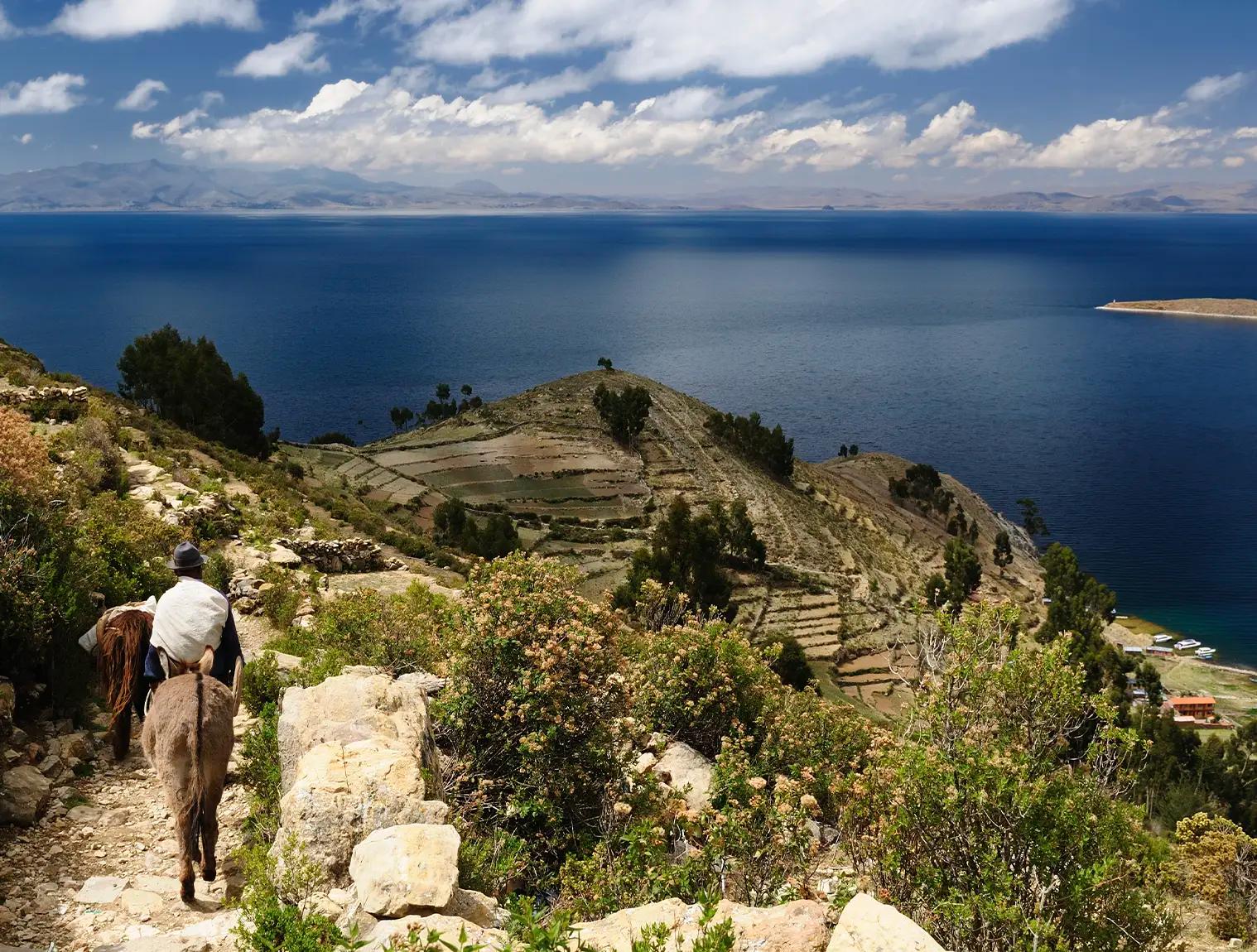
8 days from $ 1679
Machu Picchu, Cusco, Sacred Valley, Puno & Lake Titicaca
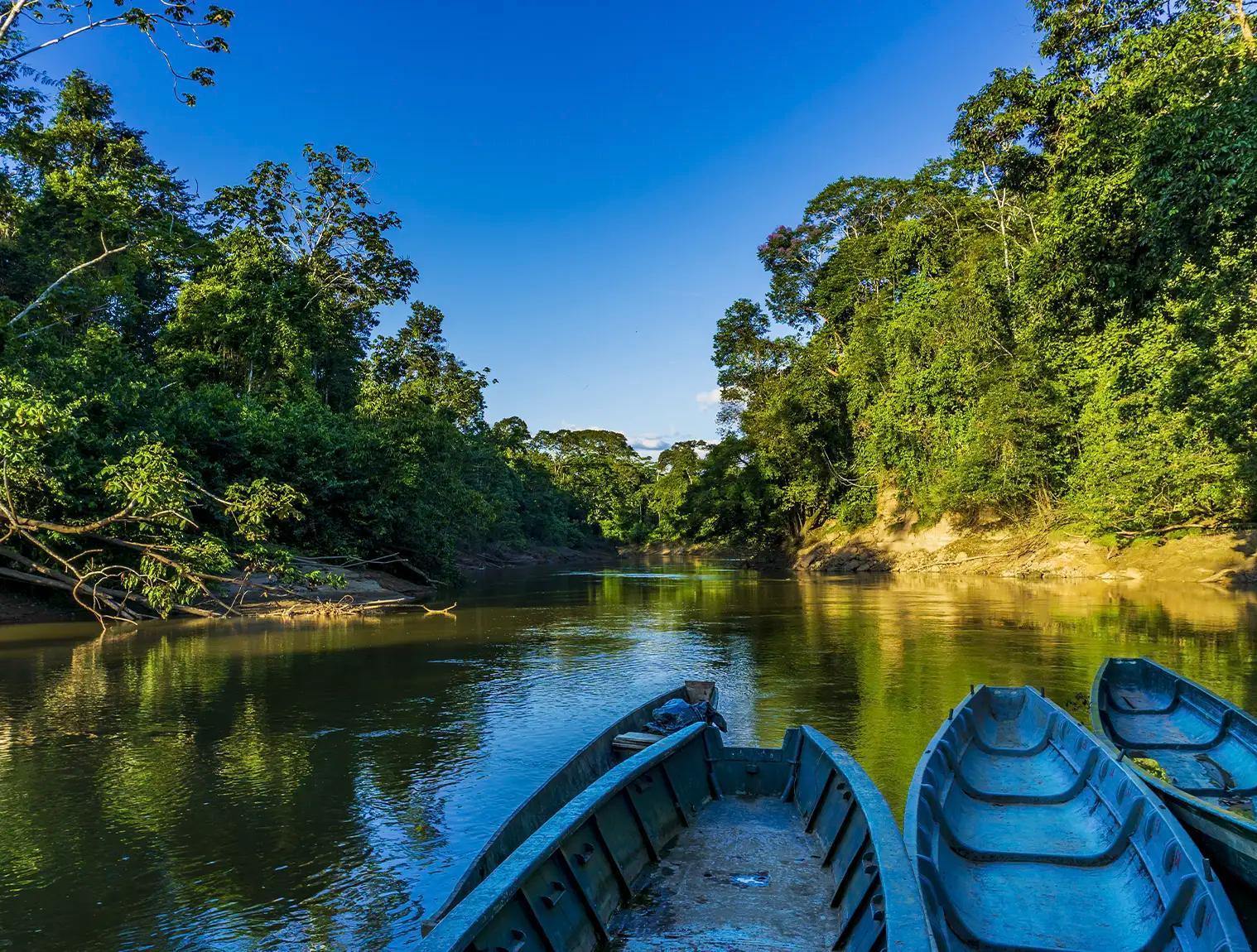
12 days from $ 2549
Machu Picchu, Sacred Valley, Cusco, Amazon, Arequipa & Colca Canyon
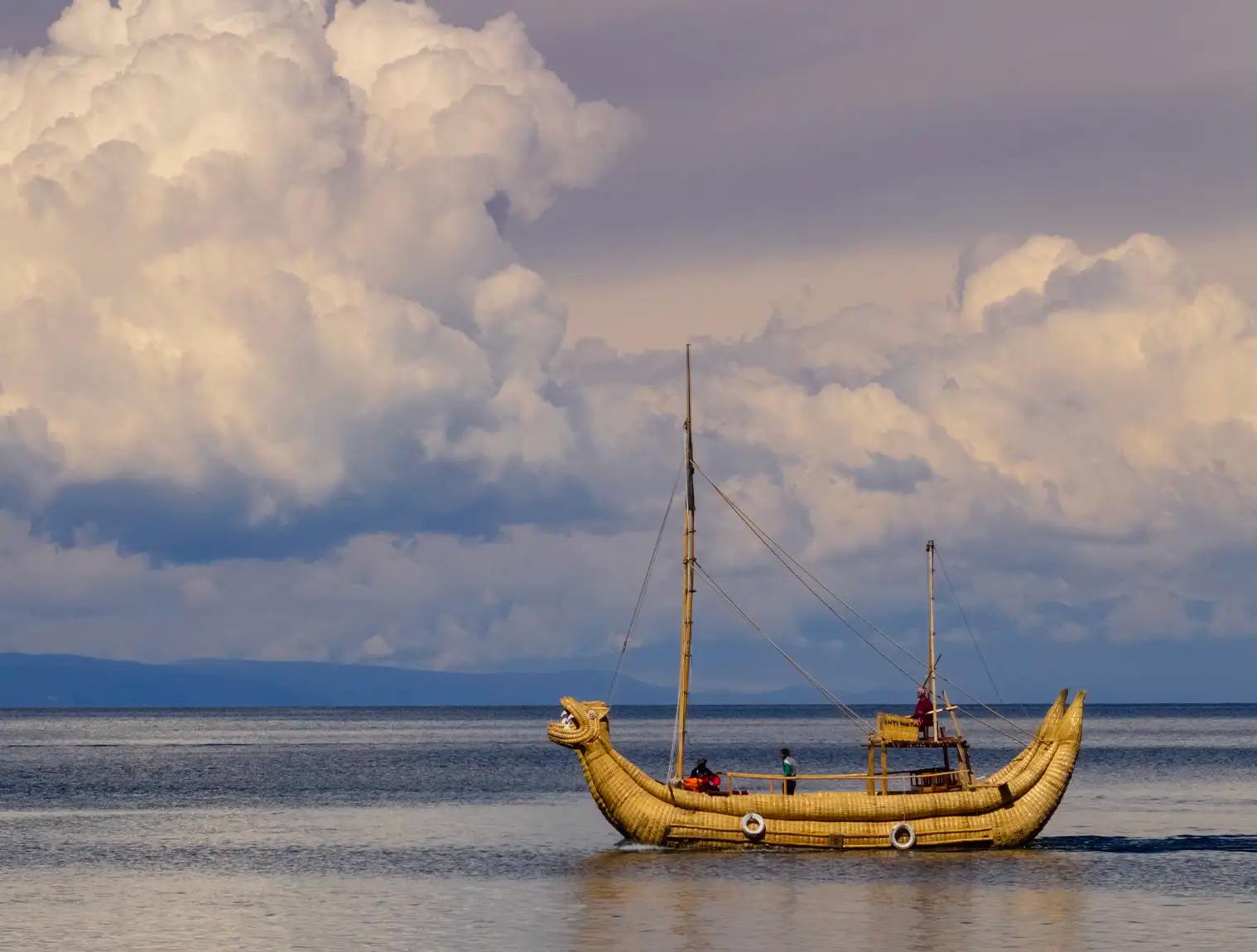
11 days from $ 2379
Amazon, Cusco, Machu Picchu & Titicaca

The most flexible booking terms!
Zero postponement fees up to 30 days before arrival, transferable travel credit , and only a 30% deposit required to secure your trip.
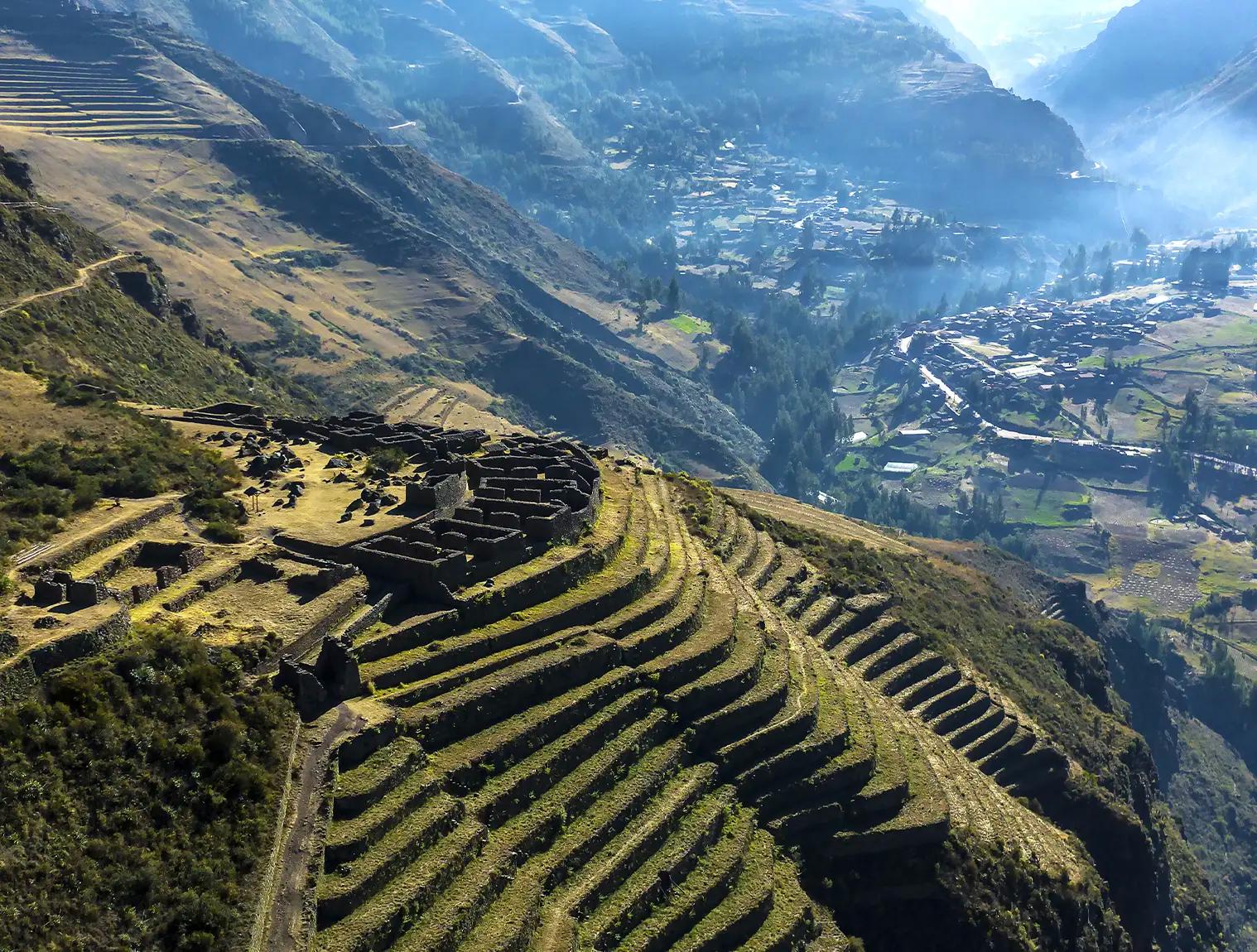
10 days from $ 2149
Lima, Arequipa, Colca Canyon, Machu Picchu, Cusco, Titicaca
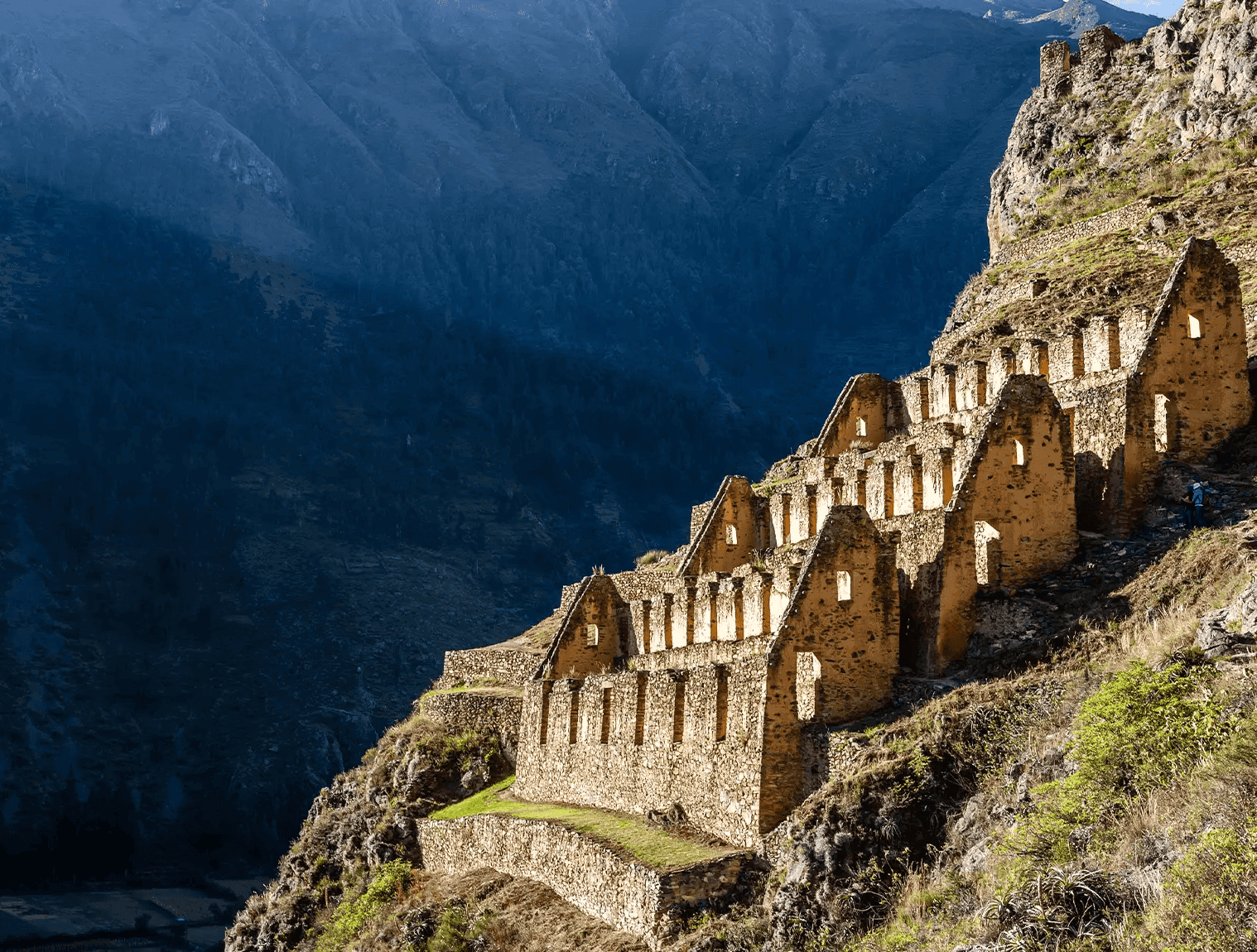
16 days from $ 3869
Machu Picchu, Cusco, Titicaca, Amazon, Lima, Paracas, Arequipa & Colca
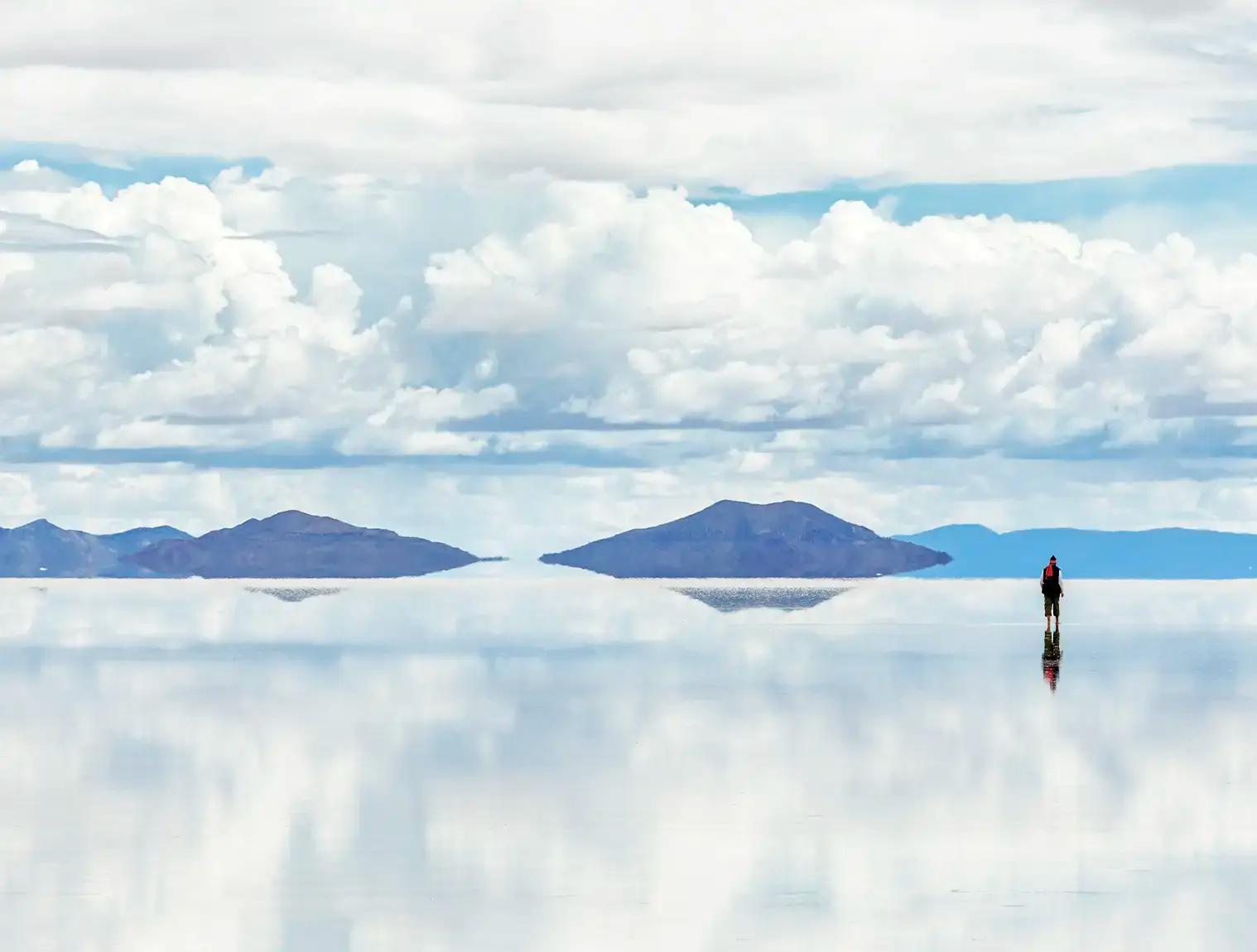
12 days from $ 3769
Cusco, Machu Picchu, Titicaca, La Paz, & Uyuni
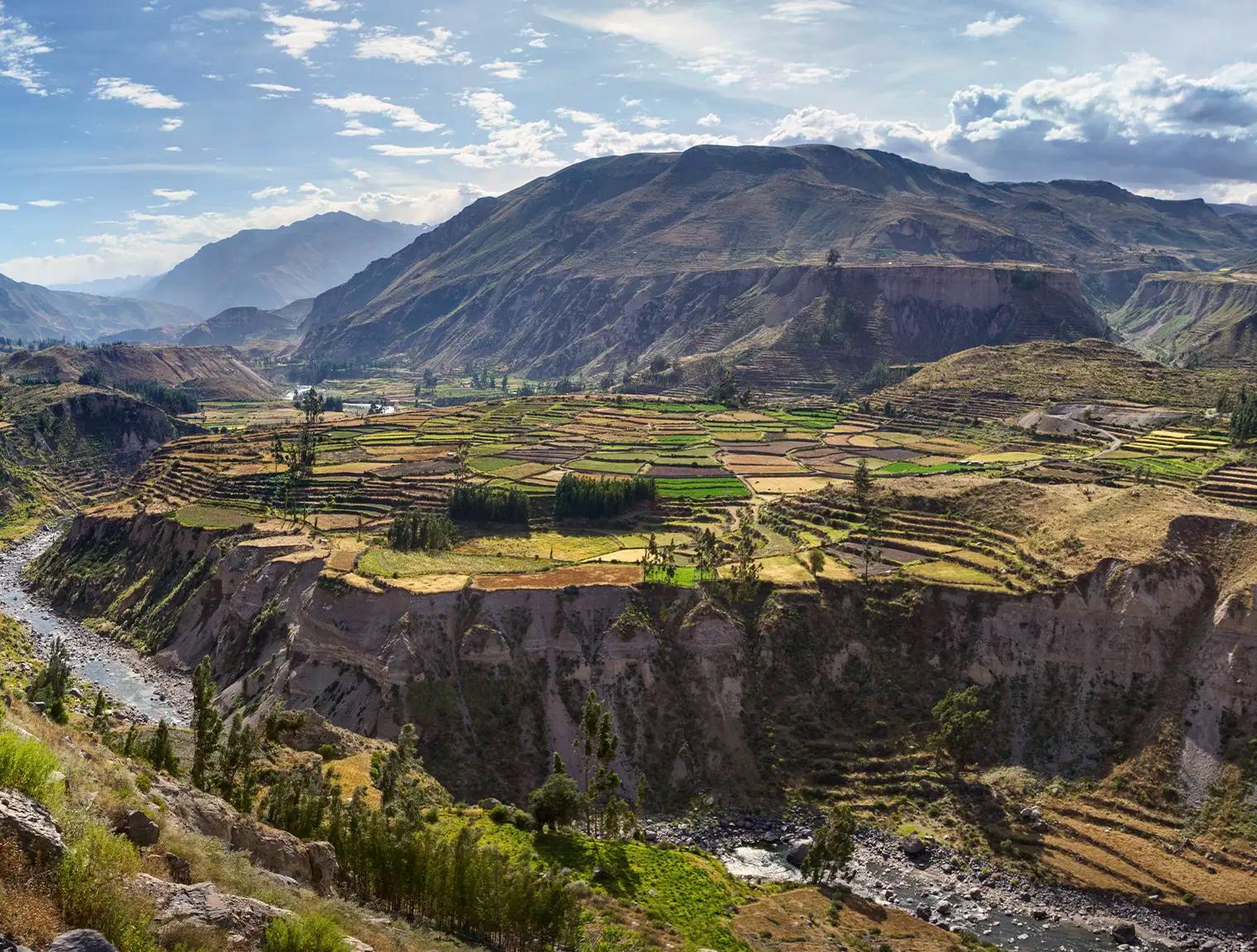
11 days from $ 2769
Machu Picchu, Cusco, Lima, , Paracas, Arequipa & Colca Canyon
Customize your Tour
What to see in lake titicaca.

The Uros Floating Islands
The floating islands of Uros are the main attraction of Lake Titicaca. The Uros community built these man-made islands from reeds found in Lake Titicaca called totora reeds, as they’ve done for centuries. As you step onto the floating islands you’ll be welcomed by their residents and educated about their way of life.

Taquile Weavers
The island of Taquile was relatively isolated from the rest of Peru until recently due to its location off the shores of Lake Titicaca. Its inhabitants, regardless of gender, have upheld a long-standing tradition of textile art. These weavings have been declared by UNESCO as an Intangible Cultural Heritage of Humanity.

Puno is celebrated as the folklore capital of Peru and hosts the Candelaria Festival every year in February. This lakeside city is the gateway to Lake Titicaca.

Candelaria Festival
Every year at the beginning of February, the Festival of the Virgen de la Candelaria is celebrated in Puno for 18-days. This vibrant festival is filled with colorful costumes, local Peruvian music, and traditional dances.

Close to Lake Titicaca, Sillustani is a cylindrical necropolis along the shores of Laguna Umayo. A pre-Inca burial site, Sillustani was built over 500 years ago by the Culla civilization. Here you can find ruins with carvings of sacred animals and 40 ft. tall towers.

Amantani is one of the real islands on Lake Titicaca, not a floating one. Here you can do a Lake Titicaca homestay with a local family to make new connections and learn more about the way of life on the island.

Cutimbo is an impressive ancient burial site close to Lake Titicaca. Like Sillustani, you can witness some impressive archaeological finds like stone tombs, cave paintings, and carvings.

Pukara Archaeological Site
The Pukara archaeological complex is located about one hour north of Puno. Inside is the Pukara Lithic Museum where you can discover weaving tools, pieces of decorated pottery, and other artifacts. Some of these pieces date back to 500 BC.
Lake Titicaca & Puno Hotels

GHL Hotel Lago Titicaca
Isla Esteves s/n, Puno

Casa Andina Premium Puno
Avenida Sesqui Centenario 1970, Sector Huaje, Puno

Lake Titicaca Hotel Puno
Avenida Chulluni 195, Puno

Casa Andina Standard Puno
Sesquicentenario 610 Sector Huaje, Puno
Peru Highlights
Peru is filled with archaeological ruins, scenic landscapes, and delicious flavors. Must-see places in Peru include:
Hike the Inca Trail to Machu Picchu in four or two days. The Inca Trail is a 500-year old pathway where the elite Incas once entered into the “Lost City of the Incas”. Plan with your Peru for Less travel advisor in advance, Inca Trail permits tend to sell out even 6-months in advance.
Amazon Rainforest
Step into the lush Peruvian Amazon Rainforest and witness a spectacular array of wildlife in its natural habitat. Lodges in Puerto Maldonado are ideal for excursions and daily activities. Those looking for a more luxurious Amazon experience would love an Iquitos Amazon River cruise. Colorful macaws, giant tarantulas, and playful river otters are among the sights you’ll behold.
Cusco city has it all, archaeological ruins, colonial buildings, top-rated restaurants, and countless places to explore. Your Cusco City Tour will take you to the top highlights like Sacsayhuaman, Q’enko, the Cusco Cathedral, and more.
Arequipa is a picturesque town and also the second-largest city in Peru. Local markets, beautifully built colonial architecture, and El Misti volcano are among the things you’ll see while walking the cobblestone streets of the white city.
Lake Titicaca
Sail on the deep blue waters of Lake Titicaca and step on the reed Uros and Taquile floating islands. Some of the best weavers are found in this area so pick up some Peruvian textiles here for unique souvenirs.
Nazca Lines
The Nazca Lines are mysterious geoglyphs and geometric shapes drawn onto the desert floor hundreds of years ago by the Nazca culture. Little is known about them nevertheless, the Nazca Lines inspire awe in those who take a flight over them.
Lima is a mixture of modern city living and historical significance. Here you’ll find Central restaurant (ranked #6 by 50 Worlds Best), UNESCO World Heritage sites like Historic City Center with the San Francisco Convent, and the best shopping in Peru.
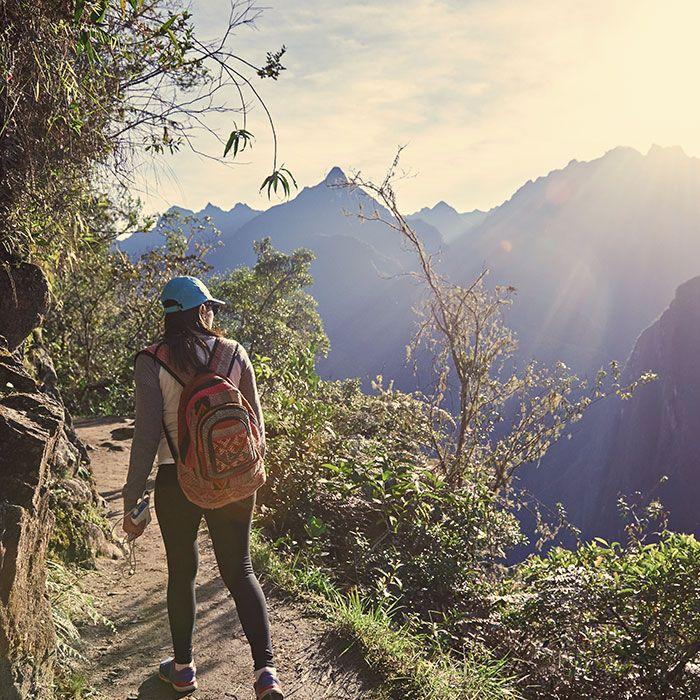
Where is Lake Titicaca?
How long should i stay in lake titicaca, what is the elevation of lake titicaca, how are the sides of lake titicaca in peru and bolivia different, how do i get from puno to copacabana, how large is lake titicaca, how deep is lake titicaca, what does titicaca mean, can i swim in lake titicaca.

Book With Confidence
We're flexible! Postpone your tour with zero cost up to 10 days prior to departure.
Email: [email protected]
Sign up to receive our newsletter for great articles, stunning photos, and special deals.
1-817-230-4971
Sales & travel support

Mon-Fri: 9 a.m. - 6 p.m. / Sat: 9 a.m. - 1.p.m. (EST/GMT-5)

SOCIAL CONTEXT PERU

LATEST UPDATE
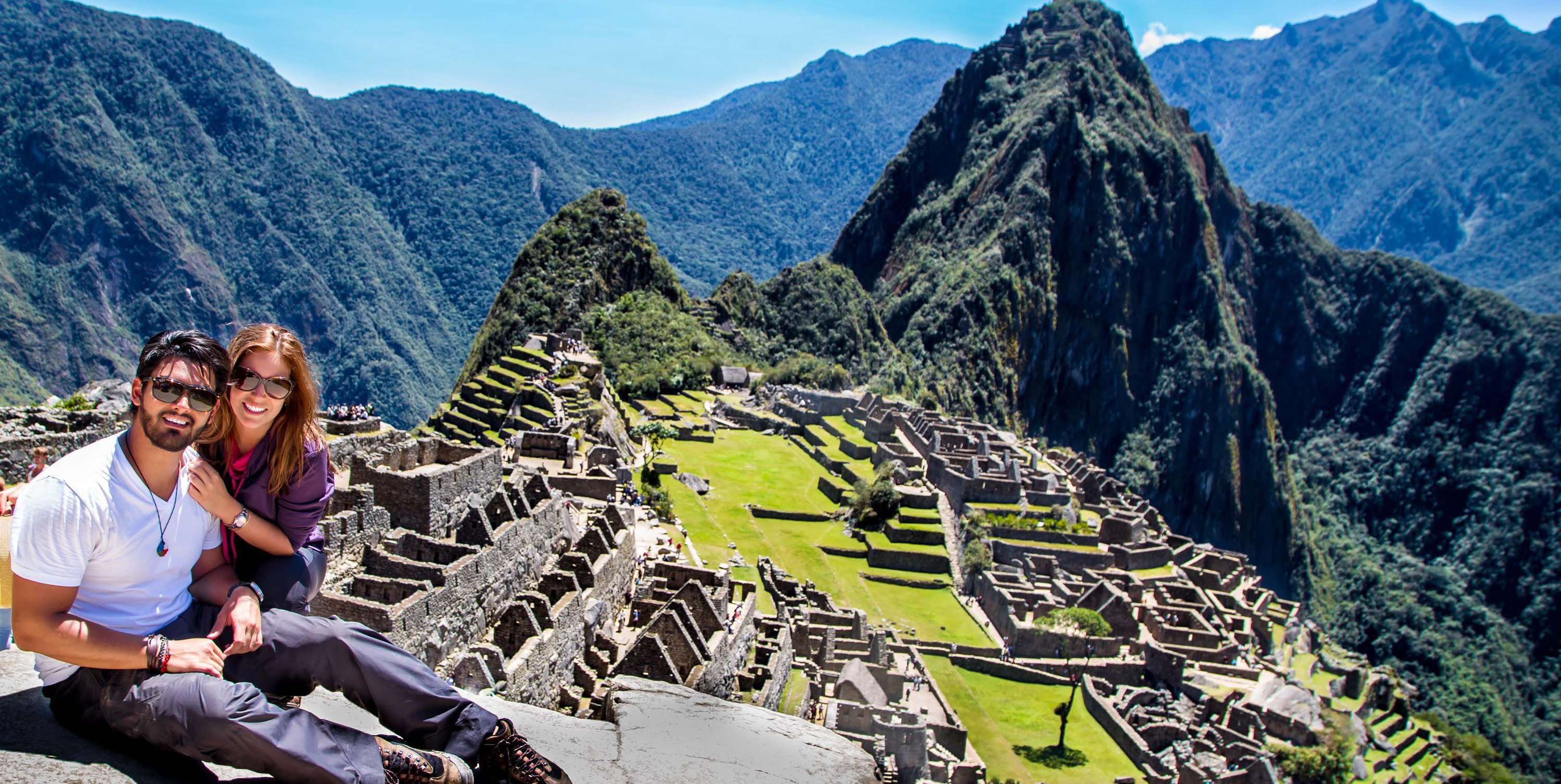
The current social context in our country urges us keep offering updated information about the daily events ocurring in our country. We are pleased to inform you that as of today,
- Visitors to Machu Picchu are entering the archaeological site normally.
- The railway between Ollantaytambo and Machu Picchu is operating normally.
- In Cusco, Alejandro Velasco Astete Airport is operating normally.
- In Arequipa, Alfredo Rodriguez Ballon Airport is operating normally.
- In Puno, Inca Manco Capac Airport resume operations.
- The road from Lima to Ica, Paracas and Nazca is open to normal traffic.
- Lima airport has been operating normally every day.
- All tour circuits are operating with regularity, passengers have been able to travel without any inconvenience.
Thank you for your preference, Welcome to the magic of Peru.
Lake Titicaca
An exciting experience: Machu Picchu and the Lake Titicaca. During the excursion of the last you will visit its famous floating islands and get in touch with its friendly people. The trip continues towards one of the marvels of the World, Machu Picchu, where you will enjoy its splendid beauty, and incomparable energy. More
Lake Titicaca is one of the most beautiful destinations in southern Peru and it is the natural frontier between Peru and Bolivia. It is known for its breathtaking scenery, its islands where ancient communities live keeping their ancestral customs intact, and also because of its millenary past, being the spot marked in the Inca legend as the birthplace of the empire. A visit to Lake Titicaca is a must do excursion before or aler your Machu Picchu tour since it is near Cusco city, just a sixty minutes flight or an eight hours bus ride far, and it will only take you two or three days. We offer you the most exciting tours in Lake Titicaca, like a visit to Uros, around forty reed islands, make periodically by its own inhabitants. Another interesting tour is to Taquile and Amantani islands, where you will have the chance to visit their prehispanic temples, learn about their ancient traditions like the knimng men, for example, all of them older than Inca times. If you prefer an overnight you can spend it in a house of a local family and live the real experience, don´t expect luxury but instead warm and cordial hosts eager to show you their lifestyle. They will share with you their daily routine, showing you how to weave the beautiful paderns they keep the same as their ancestors used to do, how to process wool, or how to dye fabrics using only their local flowers and plants, how to cook their traditional meals made mainly of potatoes, wheat and corn, and of course you will taste their delicious dishes. Less

At Last! the SECRET for the Perfect Vacation UNVEILED Click Here
Trip Highlights
- 24 hours personal assistance during your trip.
- Buffet lunch at Machu Picchu Sanctuary Lodge hotel.
- Customization of your travel experience.
- All tours with entrance fees and professional English speaking guides.
- Certified sanitary protocols: guides, drivers, transport vehicles.
- Cancellation Policy Zero Cost up to 10 days before your trip.
Schedule by Day
- Upon your arrival, reception at the airport and transfer to the hotel.
- Overnight at selected hotel at Lima.
- Our guided visit to Lima allows you to see the Historical Center: Main Square, the Government Palace, the Archbishop's Palace, the City Hall and old streets with colonial mansions and Moorish balconies. You will also visit the historic Santo Domingo Convent , an icon of colonial architecture. The tour goes all the way to modern district of San Isidro and Miraflores, where you’ll appreciate archaeological sites of sacred Inca structures and also, you will observe the Pacific Ocean coast from the vast seafront.
- Included: Breakfast.
- Transfer to Lima airport to take the flight to Cusco city.
- Transfer to the hotel.
- Visit the city declared a World Heritage Site by Unesco. The tour will start at the temple of Koricancha, an ancient Inca palace where the order of the Dominicans built an incredible church that can still be seen there. Then visit the Main Square, where the Cathedral and the beautiful Church of the Society of Jesus, among other colonial buildings, are located. Continue to the San Cristóbal colonial chruch to enjoy a spectacular view of the city. Afterwards you will go on to the fortress of Sacsayhuaman, an Inca building known for its massive walls of hewn stone, also Qenko and Puca Pucara archaeological complexes.
- Overnight at selected hotel at Cusco.
- Half day visit to Ollantaytambo, a military, religious and agricultural center of the Incan Empire. The fortress is located on top of a mountain to allow them to protect the whole valley from invaders. From the highest spot you will be able to appreciate the narrow roads along with the channels that remain unaltered since Incan times.
- Overnight at selected hotel at Sacred Valley.
- Breakfast and lunch.
- Transfer from the hotel to the train station to take the train to Machu Picchu.
- You will arrive to station in Machu Picchu town, and then you will be transported by bus to Machu Picchu citadel, one of the most renowned examples of the Inca’s architecture, surrounded by an amazing landscape of lush forest. Lost in history, Machu Picchu was not discovered until 1911 by the American explorer Hiram Bingham, but was built in the middle of XV century. At the appointed time, you will return to the station to take your train ride back to the Sacred Valley. From there transfer to Cusco city and to the selected hotel.
- Transfer from the hotel to the airport to take the flight to Lima.
- Arrival and transfer to the selected hotel.
- Transfer to Lima airport.
- International flight back home.
This is what you will get:
- Immediate response
- We will assign you an exclusive Travel Advisor.
- You will receive travel proposals in a personal web environment.
- We help you customize your trip to meet all your requirements.
- No hidden costs. Transparency and honesty.
- Zero cost cancellation policy.
- All excursions with paid entrance fees and specialized guides.
- 24 hours assistance.
- High standards of service.
- Reception at the airport and transfer to your hotel.
- Transfer to the airport.
- Flight to Cusco.
- Free afternoon to rest and acclimatize.
- You will start your excursion visiting Maras, located in the province of Urubamba, 46 kilometers West of the city of Cusco. Salt deposits are located Northwest this town. There, you will find the most important salt mines of the region, operated from the Incan times and the viceregal period.
- Then, you will visit the circular andenes in Moray, created by the Andean man with the looks of an amphitheater.
- Finally,you will go to Ollantaytambo, military, religious and agricultural center of the Incan Empire. The fortress is located on top of the mountain and allowed them to protect the whole valley from invaders. From the highest spot we will be able to appreciate the narrow roads along with the channels that remain unaltered since Incan times. Lunch will be provided at local restaurant.
- Transfer to Ollantaytambo train station to take the ride to Machu Picchu town.
- Overnight at selected hotel at Machu Picchu.
- VISIT TO MACHU PICCHU
- Today you will start your Machu Picchu excursion with a private guide. This incredible place is a renowned example of the advanced Inca’s architecture, surrounded by an amazing landscape of lush forest. Lost in history, Machu Picchu was not discovered until 1911 by the American explorer Hiram Bingham, but was built in the middle of XV century. The name of the citadel comes from the Quechua language that means “Old Mountain” and apparently was the principal Inca’s Sanctuary. Enjoy a buffet lunch at Sanctuary lodge.
- At the appointed time, you will return to the station to take your train ride back to Cusco.
- Transfer from the train station to the hotel in Cusco.
- Included: Breakfast, lunch.
- Get to know the city of Cusco, an UNESCO World Cultural Heritage site and possessor of a style on its own. The tour begins at the Koricancha Temple, an old Incan palace and main center for the worship of the sun god, Inti. Once the Spanish conquered Peru, the Dominican order built a lovely church over top this temple’s foundations: the church of Santo Domingo that is still there today. Your next destination is the Main Square, and then the adventure continues at the Sacsayhuaman Fortress built of enormous stone blocks expertly shaped by the Incas. It is strategically located at the top of a hill overlooking Cusco. What a view of the city! The tour continues with visits to three archeological sites: “Qenko, Puca-Pucara, and Tambomachay”, important religious and administrative centers for the Incas. Finally you will visit an art workshop named “Inkas Expression” that presents artists working on silver pieces and painting in wood. This is an ideal place for the ones who like andean art.
- Transfer from the hotel to the bus station.
- Depart in the morning on a special bus to Puno. During the trip you will appreciate the nearby valleys and wonderful landscapes. The route includes a stop at La Raya's pass (14107 ft. above the sea), natural boundary between Cusco and Puno, where you will get excellent photographic shots of the Andean snowcapped mountains. Then you will have a stopover at Raqchi ruins, known as the Temple of God Wiracocha. You will visit the Checacupe church, built in the XVII century, one of the most beautiful churches in Cusco; it has the particularity of having the oldest image of the Immaculate Conception in the entire Cusco and probably of America. This image has a Romanesque style with Byzantine influences. You will also see the arch bridge of Checacupe, a colonial construction that rises above the Pitumarca river. Lunch on the route.
- Upon your arrival, transfer to your hotel.
- Overnight at selected hotel at Puno.
- UROS & AMANTANI ISLANDS (LAKE TITICACA)
- Transfer to Uros, these floating islands are occupied by people known as the "Water Tribe" because they have built their own "Island" by adding periodically new layers of "Totora" a type of marram-grass very typical from this place. Then you will be transferred to Amantani Island, after a welcome you will take lunch with locals. At appropriate time you will start a hike, where you will appreciate the local culture and customs. Then you will arrive to Pachatata ceremonial center, a place where Amantani's habitants deposit every year their ritual offerings. In front it is another center called Pachamama, where the rituals and worships are offered to the cosmic deities. Return to a family house to take a typical dinner and overnight.
- Included: Breakfast, lunch and dinner.
- TAQUILE ISLAND (LAKE TITICACA)
- After a typical breakfast, transfer to Taquile Island where you will have a four hours visit. Upon your arrival you will start a hike where you will appreciate the wonderful natural sightseeings, then ascend through a regular pendant slope to arrive to the town, there you will visit the Handicraft Center where you can buy a great variety of handmade issues with very colorful and delicate designs. At proper time transfer to Puno, this time you will descend 533 stone steps to reach the main port where you will get on board for a 2.50 hours trip to Puno city. Upon arrival transfer to the selected hotel.
- CITY TOUR AND FERTILITY TEMPLE (CHUCUITO)
- This day You will visit Chucuito, the fertility temple, 18 km. from Puno. Afterwards you will have a Puno city tour: the Military Museum Yavary, the National College, the front of the Cinema of Puno, the Main Square and the Cathedral.
- At the appropriate time, transfer to the airport to take the flight back to Lima.
- Upon your arrival, reception at the airport and transfer to your hotel.
- transfer to the airport for your international flight back home.
Accomodation
- 3 nights of accommodation in Lima at selected hotel.
- 1 night of accommodation in Sacred Valley at selected hotel.
- 1 night of accommodation in Machu Picchu at selected hotel.
- 2 nights of accommodation in Cusco at selected hotel.
- 2 nights of accommodation in Puno at selected hotel.
- 1 night of accommodation at a Local homestay in the island.
Comments of our Clients

We spent some beautiful days in Peru

By Traveler: BERNARDIS Alfredo
Hello friends, we are back home after a two-day stopover in Buenos Aires. We spent some beautiful days in Peru.

It was a very nice experience
By Traveler: RAMIREZ Jose
We arrived well. It was a very nice experience. We liked everything. It was good to...

¡All was incredible!
By Traveler: ONETO Adrián
Hello Viviana I am already in Argentina. The truth EVERYTHING was amazing ... your country is very nice, excellent service...

I can begin to express how grateful I am for your service
By Traveler: TRUCKER Jennifer
Hi Viviana, I can begin to express how grateful I am for your service, knowledge, and for organizing our trip. Everything worked...

Our trip to Peru has been satisfactory
By Traveler: APARICIO Fernando
Good morning Viviana, Indeed our trip to Peru has been very satisfactory both in the services and in the organization that have...
By Traveler: ONETO
Send this itinerary to your travel partner, a friend, a family member or just to help someone start dreaming about this trip. Share the magic!
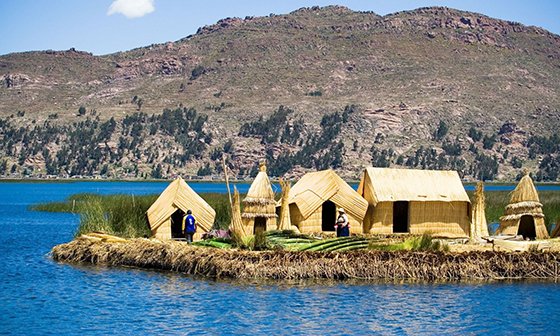
WONDERS OF PERU AND BOLIVIA
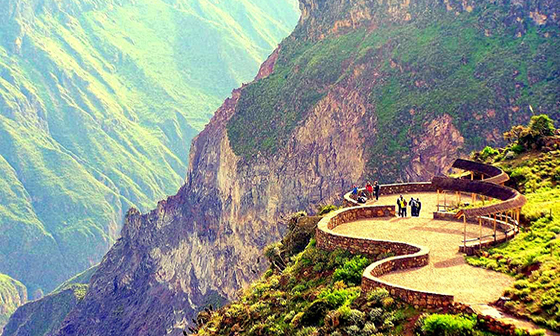
FROM THE ANDES TO THE RAINFOREST
Lake titicaca: for more adventurous.
If you are more adventurous you can do kayak in the calm waters of Lake Titicaca, near Llachon peninsula, which is a predy unique experience. Another exciting excursion is the tour to the Youth fountain, located on Sun island in the Bolivian side of the lake.
SPECIAL price, travel until 2022!
Quick quote.
Send us your details. It will allow us to organize a tailor-made trip for you.
Personal Information
Estimated travel date, how many adults and kids in your group, your travel preferences.
If you have not yet received the response from your Travel Designer, please check your SPAM FOLDER.

Must-see attractions in Lake Titicaca

Lake Titicaca
The sparkling white mudéjar (Moorish–style) cathedral, with its domes and colorful azulejos (blue Portuguese-style ceramic tiles), dominates the town…
This is a beautifully preserved village where the homes are built with flat stones joined in an earthen mortar. There is a stone church on the hilltop…
Isla del Sol
Yumani is the main village at the south end of the island. Most boats drop you at the village’s dock, about 200m downhill from the town proper. The small…
Horca del Inca
This hillside gate (named 'the Incan Gallows' by the Spaniards) is a fascinating pre-Incan astronomical observatory, surrounded by pierced rocks that…
Cerro Calvario
The summit can be reached in half an hour and is well worth the climb, especially for a view of the sunset. The trail begins near the church at the end of…
Escalera del Inca
Just uphill from the ferry dock at Yumani, along the beautifully reconstructed Escalera del Inca (Inca stairway), you’ll pass plenty of terraced gardens,…
Museo de Pariti
The stunning pots and ch’alladores (vases) found on Isla Pariti in 2004 are now on display at this tiny museum near the excavation site. Exhibits here…
Templo de las Vírgenes
The ruins of an Inca nunnery and temple dedicated to the Virgins of the Sun – also known as Ajlla Wasi or Iñak Uyu – occupy an amphitheater-like valley…
Copacabana Beach
While Bolivia’s only public beach can’t hold a candle to its better-known counterpart in Rio de Janeiro, on weekends the festive atmosphere is a magnet…
Pilko Kaina
This prominent ruins complex near the southern tip of the island is about 30 minutes (2km) south by foot from Yumani. It sits well camouflaged against a…
Cerro Kopakati
Located about 4km down the road from Horca del Inca toward Kasani, this carved stone features pre-Incan ruins and pictographs. The best known, though…
Museo del Poncho
A visit to Museo del Poncho will help you unravel the mysteries of the regional textiles. The exhibits, spread over two floors, give a clear insight into…
Ask around town for Hilario Paye Quispe. He can take you on trips around the bay in a totora-reed boat or via motorboat to the peninsula opposite (prices…
This picturesque village lies on a secluded crescent-shaped bay encased by green hills. If it’s open, there’s a basic tienda (shop) in town selling soft…
Mirador Palla Khasa
Follow the well-signposted path from Yumani's ridgeline up to this small stone lookout atop Cerro Palla Khasa (4065m) for sweeping sunset views over the…
Fuente del Inca
Early Spaniards believed Yumani’s spring was a fountain of youth and for the Incas the three streams represented their national motto: Ama sua, Ama llulla…
Museo de Kusijata
A 3km walk northeast along the shoreline from the end of Calles Junín or Ballivián leads to the community of Kusijata, where there’s a former colonial…
This is a collection of lakefront adobe houses. If you ask around, you’ll find rooms for rent for about B$30. Asociación Transport Yampu Tour Lacustre…
Museo de la Catedral
Copacabana's cathedral is a repository for both European and local religious art and Museo de la Catedral contains some interesting articles and offerings…
North of the cemetery on the southeastern outskirts of town is this neglected site of artificially sculpted boulders. Its original purpose is unknown, but…
Gruta de Lourdes
A cave that, for locals, evokes images of its respective French and Portuguese namesakes. It attracts devotees from across the border in Peru,…
This lighthouse on the tip of Kakayo-Queña Ridge is technically in an area tourists are allowed to visit, though access by land has been cut off by the…
Museo Pacha Uta
A small museum by the tourist info center that's dedicated to the natural and human history of the lake.
Capilla del Señor de la Cruz de Colquepata
This tangerine-colored chapel is located at the start of the trail to Cerro Calvario.
Chincana Ruins
Isla del Sol's most spectacular ruins lie near the island’s northern tip. Its main feature is the Palacio del Inca, a maze of stone walls and tiny…
This agreeable little village stretches along a magnificent sandy beach that could be straight out of a holiday brochure for the Greek islands. The…
Marka Pampa
At low tide an innocuous-looking column of rock peeps just a few centimeters above Lake Titicaca’s surface, north of Isla del Sol. Most locals dismiss it…
Mesa Ceremónica
About 150m southeast of the Chincana ruins is the Mesa Ceremónica. It’s thought to have been the site of human and animal sacrifices and makes for a…
Piedra Sagrada
From Cha’llapampa Village, the Chincana route runs parallel to the beach, climbing gently along an ancient route to the isthmus at Santiago Pampa (also…
Cha'llapampa Museum
The small Cha'llapampa Museum contains artifacts excavated in 1992 from Marka Pampa, referred to by locals as La Ciudad Submergida (Sunken City). Among…
Templo del Inca
Over the track, and in a field just southwest, from the Piedra Sagrada, are the ancient walls of the complex known as the Templo del Inca. Although little…
Of the more than 80 Inca ruins on the island, most date to the 15th century AD. You could spend a week looking at them all.
Some obsidian remnants among the ruins indicate contact with people as far away as Colca Canyon, Arequipa, Peru.
Cha’llapampa
Most tours visiting the northern ruins land at Cha’llapampa, a small village straddling a slender isthmus.
Museo Étnico
Some dusty exhibits, including Inca pots. Admission is free with the Cha’lla trail fee.
More destinations you need to see
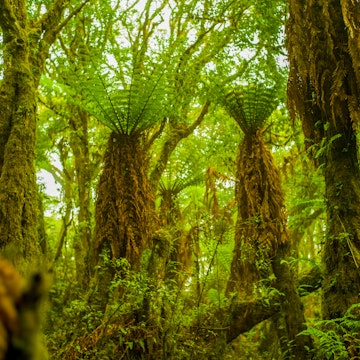
- Ecuador & The Galapagos
- NEW: Costa Rica!
- Multi-Destination Custom Trips in Latin America
- Highlight Tours
- Cultural Travel
- Community-Based
- Culinary Trips
- Adventure Tours
- Hiking Tours
- Family-Friendly
- Off-the-Beaten-Path
- Day Tours in Peru
- Multi-Day Tours in Peru
- Build your Trip in Peru
- Day Tours in Ecuador
- Multi-Day Tours in Ecuador
- Multi-Day Tours on the Galapagos
- Build your Trip in Ecuador
- Build your Trip in Costa Rica
- Cultural travel
- Community-Based Tourism
- Off the Beaten Path
The Floating Islands on Lake Titicaca
Lake Titicaca is definitely one of Peru’s highlights and a must-see for most people who have decided to travel to this vast country. Situated half in Peru, and half in Bolivia, it is presumably the largest lake in South America. It is also the highest navigable lake in the world, sitting at an altitude of 3.810 meters (12.500 feet).
This lake was already of great importance at the time of the Incas. Legend has it that Titicaca is the “birthplace of the sun”. It tells that the god Viracocha emerged from the lake, creating the sky, sun, moon and stars. As well as the first people of the Andean world. The Inca people believed that their souls would go back to where they came from, namely Lake Titicaca. Therefore, the lake held a very special place in their culture.
Nowadays, it is not less important than it used to be, but its function has evolved throughout the years. In 1987, Lake Titicaca has been declared a National Reserve of Peru . This with the objective to preserve its natural beauty and resources. It is home to distinctive biodiversity and also a place where ancient traditions are being kept alive.
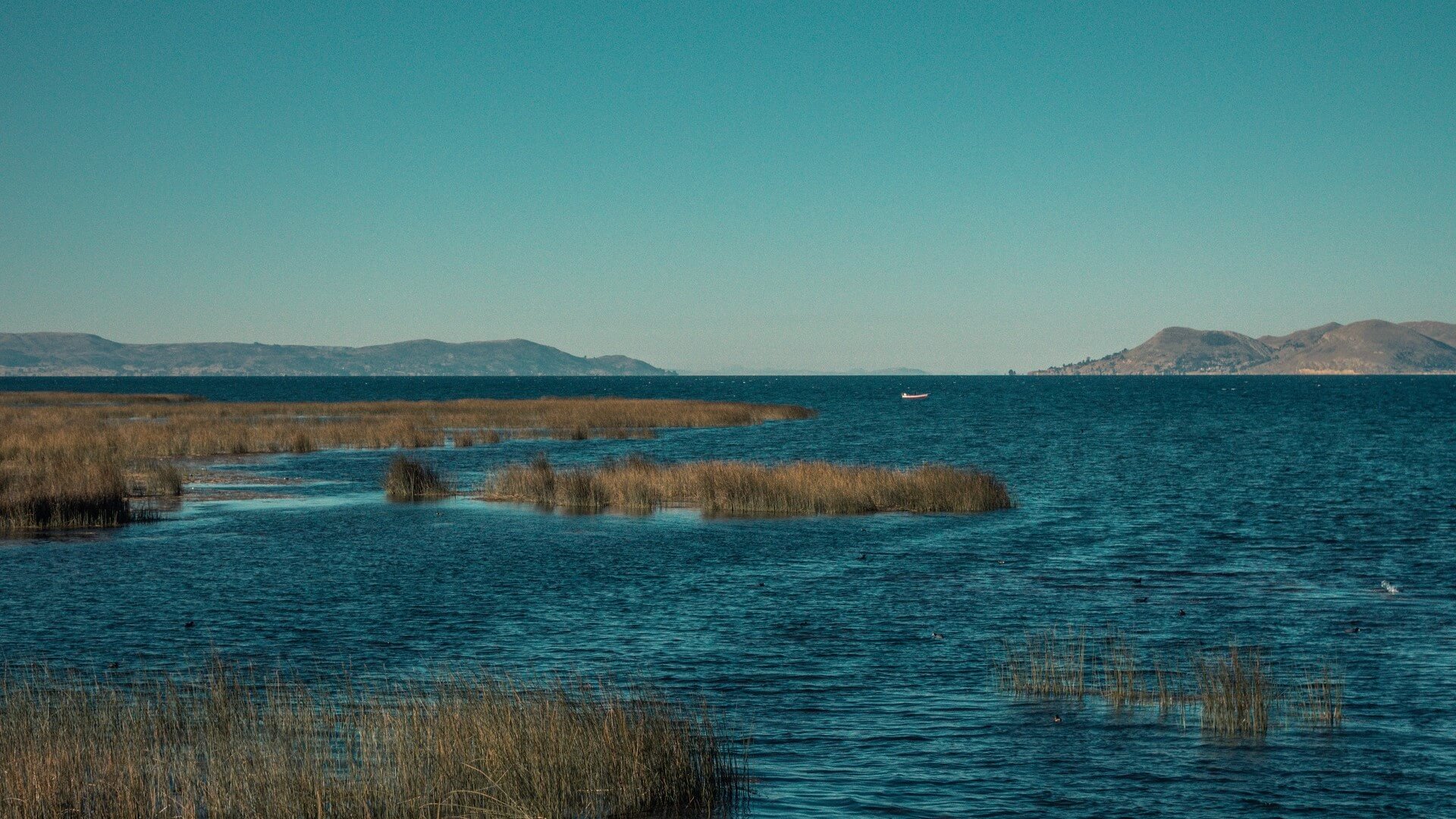
The Uros Floating islands
In the world of tourism, Lake Titicaca is especially well known for an attraction that does not have its roots in the Inca culture: the Uros floating islands. These islands are built out of totora reed growing in abundance on the lake. The inhabitants collect totora reeds floating on the lake, build huge floating blocks out of them and attach them to the ground of the lake to give them stability.
Different theories as to the origin of the floating islands exist. One of them affirms that the Uros people were already building such islands on Lake Titicaca before the arrival of the Incas. Another theory says that the Uros started this tradition trying to protect themselves from the Incas and other cultures. Yet another one refers to their will to escape the Spanish people invading their territory.
All floating islands consist of totora reeds in their integrity, not containing any other material. The same reeds are also used to build homes, boats and crafts. Of course, the part of the islands that touches the water is constantly rotting away. While this natural process is of great importance (as the gas produced by it keeps the islands floating), it also obliges people to always rebuild their work on the upper side for it to be maintained.
It is not a big surprise that such a unique tradition arouses interest among tourists visiting Peru. Seeing how people live on floating islands in the midst of a lake at 3.810 meters (12.500 feet) of altitude is something they do not want to miss by any means. By the way, if you are among these people, you should definitely inform yourself about acclimatizing to the high altitude, in order to enjoy your visit to the fullest. Read our blog on How to stay safe and healthy when traveling to Peru , to find out how!
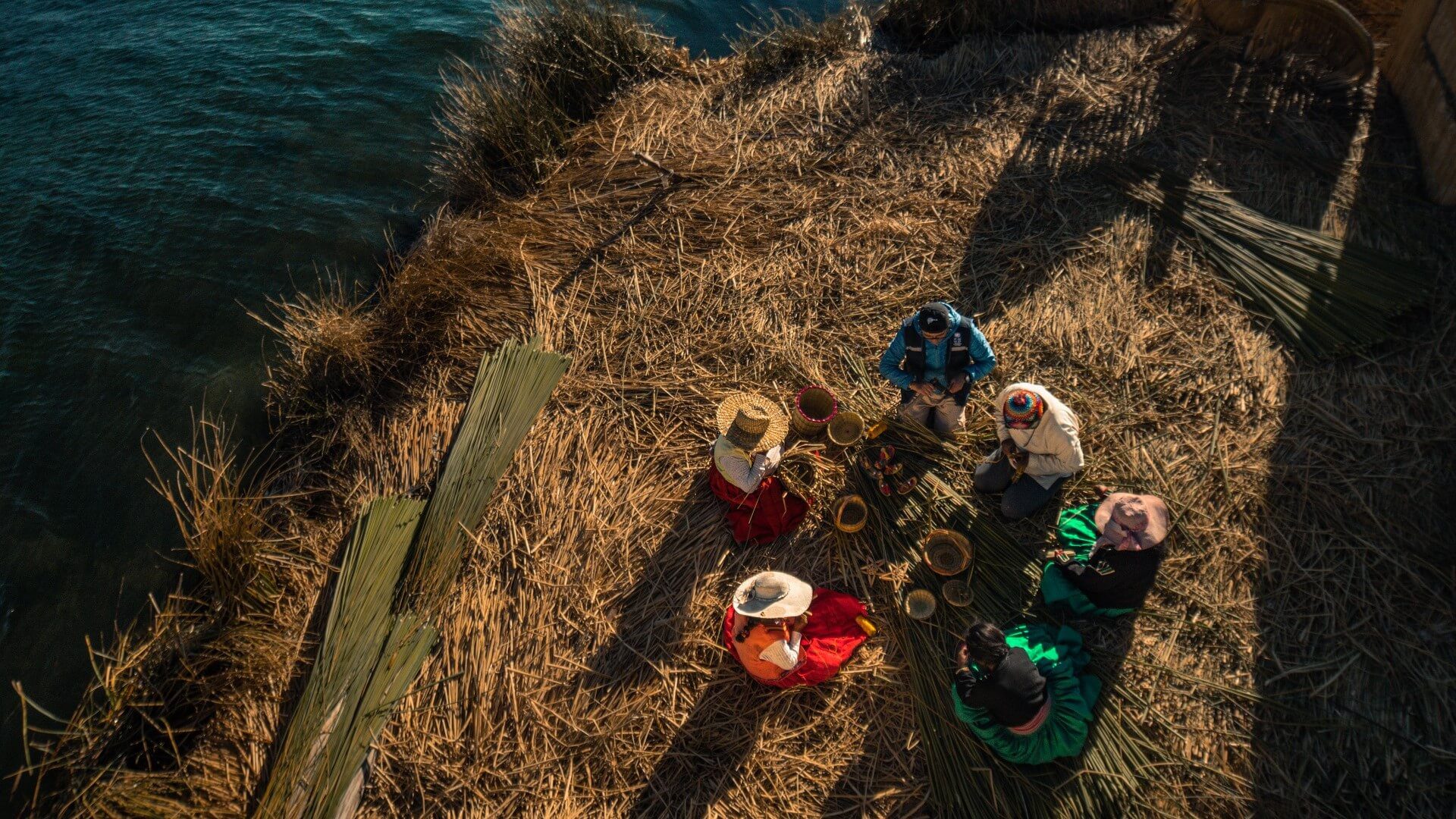
The conventional Uros islands: What’s the issue?
The truth is that the “normal” Uros islands have been subject to excessive commercialization, which in turn has led to the experience losing its authenticity. But what exactly is the story of these islands and their inhabitants, and why do they tend to have such a bad reputation? Let us clarify some things that only very few people do, but everyone should , know about.
What we see on the surface, is that a significant amount of boats filled with tourists go to the Uros islands every day to show the visitors a different way of life. However, most people you will meet here don’t exclusively live on the islands. Most of them have settled into a home in Puno. People want to move to the cities, looking for richness and progress. Here, they have access to health care and can send their children to High School or university. On the floating islands, there is only a primary school.
Unfortunately, some of the Uros people, that could not invest a greater amount of money, live under precarious conditions in Puno. They accept their situation, knowing that the city offers them opportunities that they lack on the islands. But generally, most of them prefer spending their time on the islands. Here, they earn better money from tourism, live in tranquility and watch their children play in these beautiful surroundings.
So, whenever they can, the Uros people go to the islands to spend their days. There are currently about 32 of these islands. The ones sitting closest to Puno receive tourists almost every day. The more remote ones, who receive fewer tourists, engage in fishing and gathering to make a living.
Touristic experience
But despite all of the love the local people have for their islands, and their wish to maintain their traditions, the touristic experience here has become somewhat artificial. Once you arrive on the islands, people will sing for you in several languages and let you go on a boat ride on totora boats with dragon heads. Then, they will show you their artisan work, invite you to their homes and try to sell you some of their crafts. All of this, if we are honest, can feel more like an attraction park than an actual authentic experience of cultural exchange.
The reason for this situation is that tourism is simply excessive here. With so many boats making their way to the islands every day, the place has become subject to a lot of competition. The inhabitants envy each other, wanting to receive more tourists and receipts from this lucrative activity. It’s just the way it goes sometimes when large sums of money are involved.
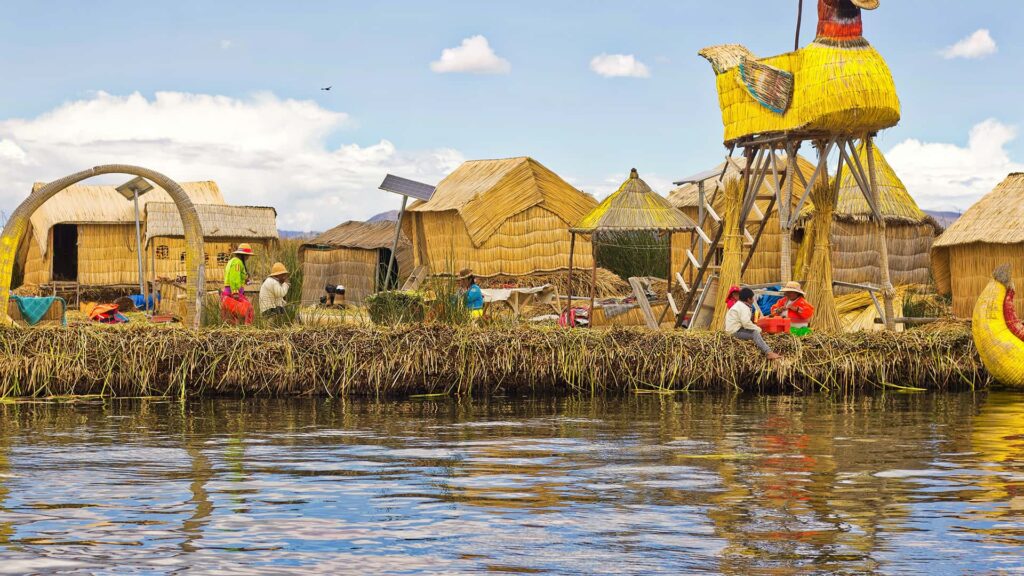
Should we go or not?
Due to this situation, we have already had travelers considering to refrain from a visit to this place. This because they have come to hear about the reality of the Uros islands. The truth is, even we sometimes sell experiences taking people to the conventional Uros islands. This is the case on our Lake Titicaca Tour with Homestay on Taquile Island . We do that because it is the most available and cheapest option to get you to Taquile island. Group transportation options do generally pass by the Uros islands, and we cannot change that as we’re not directly operating these boats.
But apart from that, we should simply try to adopt another point of view and, instead of condemning the Uros people, ask ourselves what has lead to the current situation. Knowing that these people live with one foot in Puno and with the other one on the islands, being surrounded by a very competitive atmosphere, we might just understand their behavior a bit better.
Moreover, by sending our travelers to the conventional Uros islands, we have also learned that it can even be interesting for you to see different ways of organizing tourism. In the Taquile tour, we take you to the Uros islands first, where you witness all of the above mentioned experiences. After that, you will head to Taquile, where you will spend time in a homestay, engaging in more Community-Based Tourism . Here, you will understand the importance of maintaining authenticity.
Despite everything, we understand if you want to avoid the Uros islands. If that is the case, we can reassure you: there are definitely ways to go to Titicaca and even to the floating islands, and still have a completely authentic experience there. And we are about to tell you about them!
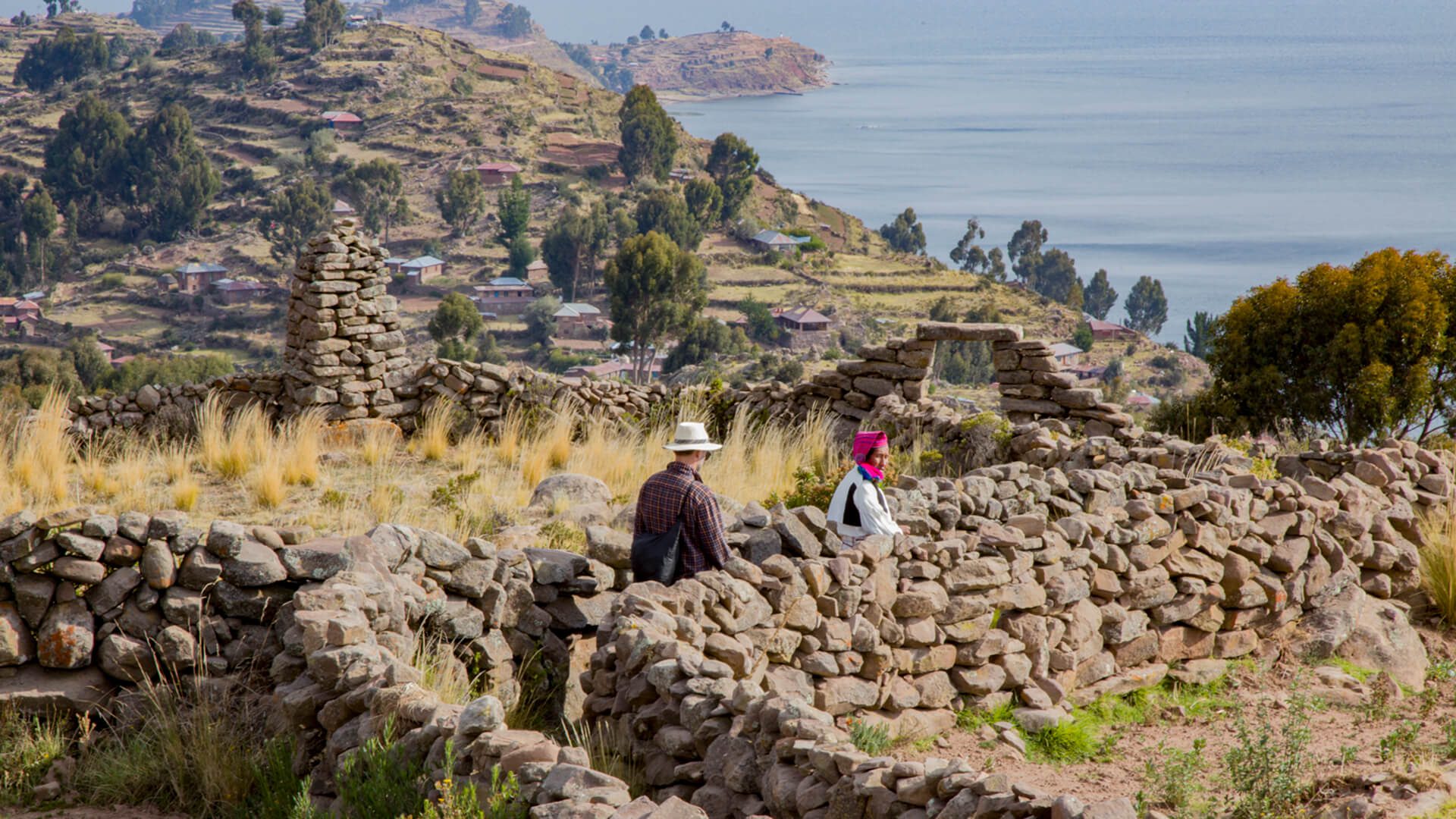
Uros Titino islands on Lake Titicaca
The Uros Titino islands are more difficult to access than the “normal” ones. Conventional transport services don’t pass by them, which is why most people don’t visit these islands. Thanks to that, tourism here has not been commercialized in the same way as on the normal Uros Islands.
On Titino, you get the opportunity to meet people who do indeed reside here permanently. Therefore, we are sure to say that when coming here, you will live the beautiful experience that you have been dreaming of when thinking about Lake Titicaca.
At the same time, the money you will spend here is a great help for the people living on the islands. Unlike the people living in Puno, who dedicate their time to other commercial activities back there, the Titino people do not work in the city, which is why your support means a lot to them. On our tour From Puno to Cusco the Impactful way , the Uros Titino islands are among the places you will visit. As the name says, this tour ends in Cusco and is a great option if you want to book an experience and transport at the same time.

Chimu islands on Lake Titicaca
The Chimu community has also taken up the habit of building floating islands. Unlike other floating island communities, they don’t and have never actually lived on the islands. Their ancestors did in fact live at the coast, close to what is today Trujillo. From there, they migrated to Lake Titicaca, settling at its shore.
Here, the men of the Chimu tribes used to go on expeditions of up to four days, in order to collect totora reed, fish, hunt and search for birds’ eggs. To succeed in this task, they started the habit of building small floating islands, which served as a kind of base camp for their expeditions on the lake.
Despite their hunting and fishing skills, the Chimu people identify first and foremost as artisans. They are especially endowed when it comes to spinning and fabricating different types of objects from totora reed, a skill they have imported from their origin in the North of Peru. Unfortunately, as in many parts of this country, traditions have lost some of their importance within the Chimu community.
Help from the United Nations
Thanks to an effort made by the United Nations, their customs and traditions have been revitalized and their cultural identity maintained. Still living on the mainland, as they always have, they do like to show their tradition of building floating islands. Today, they create such islands explicitly to share their ancient culture with tourists visiting them. Their aim is to give value to their extraordinary artisan skills, which they are more than proud of.
As you can see, the Chimu floating islands are yet very different from the Uros Titino or the conventional Uros islands. In fact, they have just opened up to tourism, which is why coming here is a whole new experience with very few tourists around. If you are intrigued about this recent option to visit the Chimu floating islands of Lake Titicaca, our tour with the same name should be just right for you: Chimu Floating Islands .
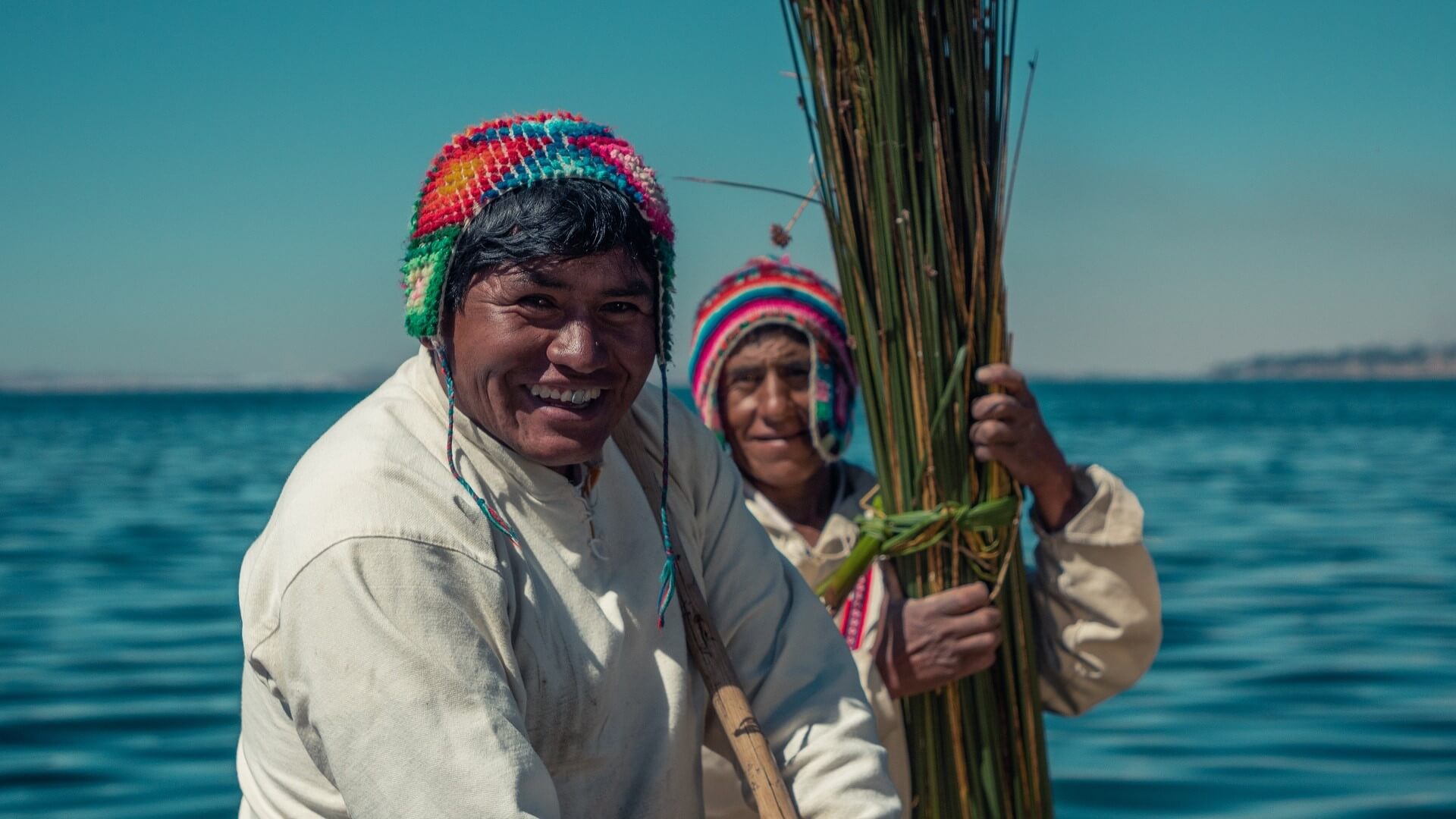
Visit Lake Titicaca your way
Clearly, there is not only one way of visiting the famous Lake Titicaca. We cannot even say that there is necessarily a right or wrong way to do it. Things are never black and white, as you might have realized if you have already read some of our other blogs .
In this article, we have shown you the different available options and explained to you why even at Impactful Travel, you can find a tour taking you to the very touristic Uros islands. Now, it is up to you to decide, which experience you want to go for.
One thing is for sure: Lake Titicaca is and will always be a magical place, which we think is unique in this world. One way or another, you will enjoy your visit to this emblematic destination; you will feel the energy it transmits and live a truly calming experience. When leaving the lake, you will feel all relaxed and full of new momentum to continue your journey.
Whichever option you choose, of course, it is always in our and everyone’s interest to travel in the most responsible way possible. Even if you go to the conventional Uros islands, it is in your hands to respect the place that you visit. This means not contaminating the lake and respecting the people you will meet. If you want to make sure to behave in the right way during your whole trip, you might want to read our article on How to Travel with Impact .
Explore all our tours on and around Lake Titicaca
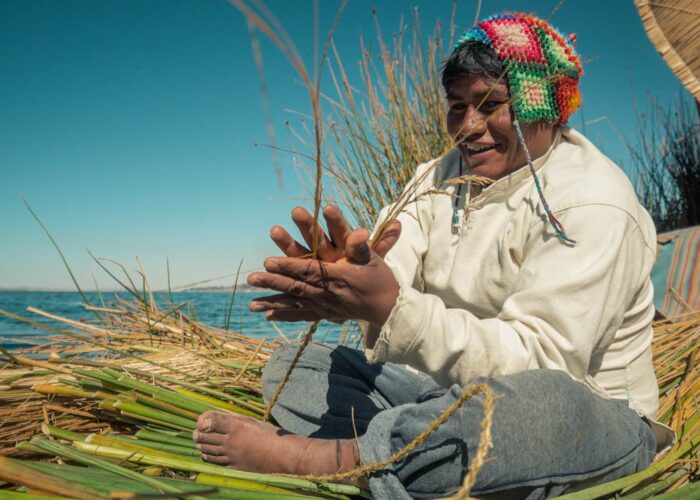
Chimu Floating Islands
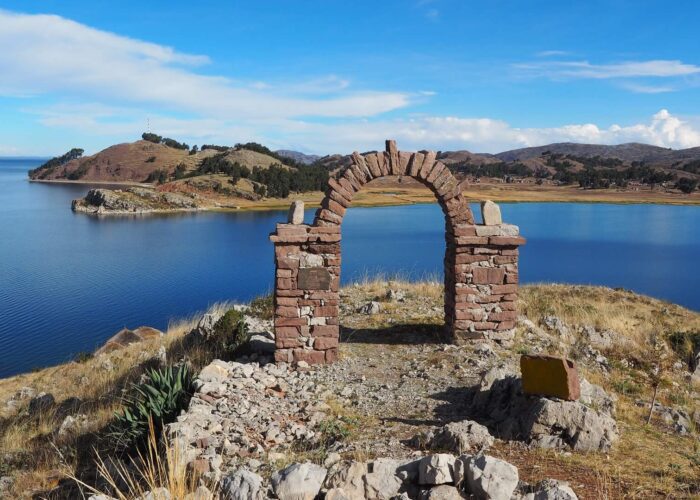
From Puno to Cusco the Impactful Way!
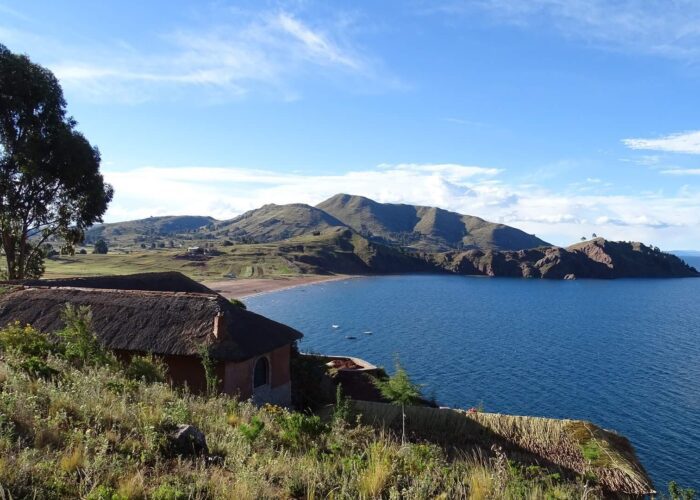
Quick Titicaca experience from Puno to Cusco
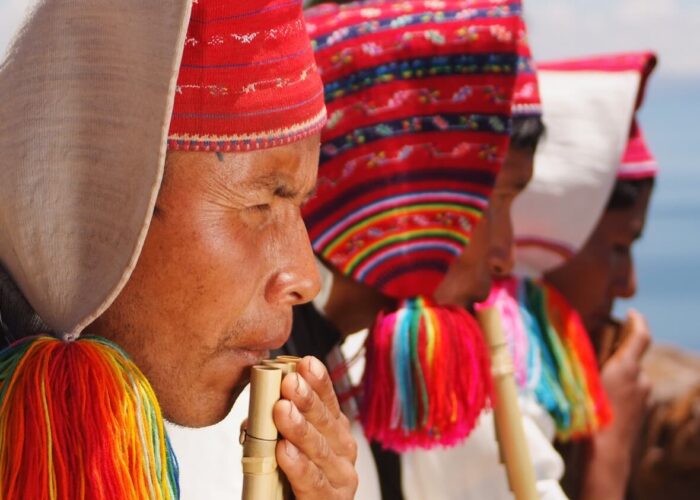
Lake Titicaca with homestay on Taquile island

Hosts of the Great Inca Trail, the Qhapaq Ñan, on Lake Titicaca
Leave a reply cancel reply.
Save my name, email, and website in this browser for the next time I comment.
Looking for something?
ABOUT IMPACTFUL TRAVEL Impactful Travel's mission is to empower transformative journeys through sustainable and responsible experiences, we are committed to enriching lives - both for travelers and local communities in Latin America. We seek to connect meaningful tourism experiences with a committed global audience, enhancing communities and encouraging sustainable choices. Together with you, we improve day by day, on the always-demanding path towards sustainability.
Recent Posts
- “I want to travel sustainably but I’m not sure how or where to begin…”
- How safe is Ecuador to travel in 2024?
- Standing Tall and Close to the Sun: The Surprising Truth about Mount Chimborazo
- Alexander von Humboldt: Discovering the World from Chimborazo
- Tarapoto Travel Guide: our most original jungle destination in Peru
- Adventure Travel
- Destination Guides
- Ecuador Inspiration
- Ecuador Tips & Guides
- Our Impactful Story
- Peru Inspiration
- Peru Tips & Guides
- Peru Travel Style Guides
- Practical Information
- Practical Information Ecuador
- Sustainability
TOURS IN PERU AND ECUADOR

The Route of Goodies to Machu Picchu

Coca Leaf Reading Counseling in Cusco

Fire Ceremony in Cusco
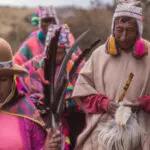
Mother Earth Pachamama Ceremony in Cusco

Ecuador and Galapagos: Quick Highlights Tour
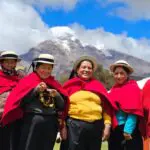
Balanced Ecuador Expedition
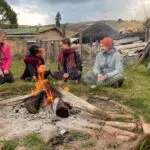
Complete Ecuador Adventure: Nature and Culture
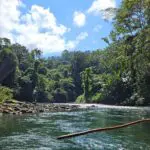
Impactful Journey to the Heart of Costa Rica

Exploring Northern Peru’s Spectacular Wonders
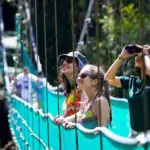
Pure Impact: the Essence of Costa Rica
Read other topics:.

- Work With Me
- SEO Services
- All Destinations
- Philippines
- Timor-Leste
- United Arab Emirates
- Czech Republic
- Netherlands
- Switzerland
- ALL Oceania
- New Zealand
- ALL North America
- United States of America
- ALL South America
- South Africa
- Adventure Travel
- Budget Travel
- Nature Travel
- Digital Nomad Life
- Australia – Sydney
- Colombia – San Andres
- Costa Rica – Tamarindo
- Czech Republic – Prague
- England – London
- Guatemala – Antigua
- Labuan Bajo
- Nusa Penida
- Japan – Tokyo
- Puerto Escondido
- New Zealand – Queenstown
- Netherlands – Amsterdam
- Spain – Barcelona
- Thailand – Bangkok
- UAE – Dubai
- Atlanta, Georgia
- Los Angeles, California
- Miami, Florida
- Orlando, Florida
- Vietnam – Ho Chi Minh
- Plan Your Trip
- Blogging Tips
- Boost Your Traffic For Free!
Visiting Lake Titicaca In Bolivia: All You Need To Know
If you’re in Bolivia, there are many things to do and places to see. One famous (and unmissable) attraction in Bolivia is Lake Titicaca.
This lake is shared between Peru and Bolivia. 44% of it is on the Bolivian side and is smaller in comparison with the Peruvian side, but the backdrop of the snow-capped Cordillera Real of the Bolivian side gives us a magnificent view.

The lake was once home to the ancient Tiwanaku culture, which left traces of their civilization behind in the architecture and complex agricultural systems. After the mysterious disappearance of the Tiwanaku, other groups of people like the Quechua and Aymara have since lived in that land and have maintained their rich, centuries-old folk traditions.
In the Andes plateau, this lake serves as a source of drinking water and food for the population around and is vital for their existence too. The environment that this place creates is a beneficial microclimate that makes possible the cultivation of potatoes and grains such as quinoa, barley, and corn. Also animal husbandry.
So this lake has to be to visit on your trip to Bolivia and has to be on your Bolivia to-do list, because of the beautiful views, stories, quietness and the history.
At A Glance
Where is Lake Titicaca?
How large is lake titicaca, how deep is lake titicaca, what’s lake titicaca elevation, how to get to lake titicaca from la paz, bolivia, 1. cerro el calvario, 2. la horca del inca (inca gallows), 3. la boca del sapo (the frog’s mouth), 4. basílica de nuestra señora de copacabana, 5. isla de la luna (moon island), 2. templo del sol, 3. inca stairs, 4. fuente de las tres aguas (fountain of the three waters), 5. the peak behind the town, isla del sol , lake titicaca facts.
Lake Titicaca is located just 72 kilometres (45 miles) from the city of La Paz, so it’s possible to be there in approximately 3 to 4 hours.
Covering 8,300 square km, it’s the second-largest lake in South America. Lake Maracaibo in Venezuela is the largest.
Lake Titicaca lies approximately 3,812 m above sea level and is the highest, commercially navigable lake not only in South America but in the world. The deepest point (283 m) is located in the northeastern section of the lake.
Important to know that Isla del Sol is located at a height of 3,925 meters (12,900 ft) above sea level. For this reason, fast movements, running or making great efforts should be avoided so as not to feel altitude sickness (you can take sorojchi or soroche to combat this!).
To reach our destination, we begin our journey in the city of La Paz, at the “Terminal Cementerio” ( Location ), the same one that is in front of the General Cemetery.
The Cementerio terminal is in itself just a street where there’re several buses and/or minibuses that go to Copacabana, a town on the southern shore of Lake Titicaca.
Depending on where you’re staying in Titicaca, you can get to the terminal by minibus (the word “cemetery” must be written on the sign), taxi (indicate that you are going to the “general cemetery”) or cable car (red line, stay at the cemetery station) and always consider the help of our friend Google maps to be sure.
There, you’ll sometimes find many buses or minibuses (vans) that go to Copacabana. The duration of the journey could be from 3 to 4 hours depending on what transport you take.
Take note that on the way there’s a stop in a town and strait called Tiquina, where it’ll be necessary to get off the transport to take a boat and cross that strait since it’s not possible to cross by another means. The bus or van will cross in another boat specifically for cars. Once on the other side, you can then board the bus again to continue the rest of your journey.
A recommendation, write down the license plate number of the vehicle so that way you don’t get confused or lose your transport. In the case you rent a car or go in a private vehicle, you can cross together with your vehicle.
Things To Do In Lake Titicaca, Bolivia – Copacabana
We’ve broken down the things you can do around Lake Titicaca by the things you can do on the mainland, Copacabana, and the things you can do on the island of Isla del Sol (Sun Island), which is usually the island people would go to when visiting Lake Titicaca.
Copacabana is a nice town between hills on the shore of Lake Titicaca. There are many things to see from this point. This is also the point where you disembark to the islands (Sun Island, Moon Island and floating islands) on boats via tours.
Copacabana is known to be an enigmatic place because it was a site of Inca religious pilgrimages. Later when it was adopted by the Catholics, Copacabana became home to important festivities, such as the pilgrimage during the holy week or the festival of the Virgin of Candelaria .
Despite not being a very big town, different activities can still be done. On the coast, there are small canoes that the locals rent so you can explore the lake on pedal boats and giant water wheels. In addition to that, you can also go hiking, enjoy nature, the views and monuments.
There are several restaurants where the dish of the day is Trout, since there are many hatcheries in the lake, but you can also find other types of food.
Here is a list of the main places to see in Copacabana.
This hill has a height of approximately 120 m (394 ft), lined with monuments representing the 14 stations of the cross, the series of images depicting Jesus Christ on the day of his crucifixion.
This place is visited by many pilgrims for penance and tourists climb it because the top offers unsurpassed views of both the city, its beaches as well as the lake itself. If you’re lucky, you can even see a part of the Andes mountain range.
The sunsets here are wonderful. It’s a climb that’s not considered difficult but some people may find it difficult due to the elevation and the number of steps. However, it can be done successfully by taking breaks to rest. The round trip trail is 1.3 km (0.8 mi) and is good for all skill levels.
Also called Pachataca, this place is 500 m (1640 ft) to the south of Copacabana, in the Kesanani hill. It’s a monument made of rock, a set carved, comprising 2 independent vertical blocks, the largest measuring 6 m (20 ft), and a single stone as a crossbar.
Wrongly named the Horca del Inca by the Spanish people because they didn’t understand the meaning of the monument, the closest meaning of this is Pachataca (a place where time is measured) because it’s an astronomical observatory, with all the elements that allowed us to verify the solstices and equinoxes. According to archaeological verifications, it’d have antiquity that dates from the year 1,764 AC.
And of course, it’s also an excellent viewpoint.
In this place, you can find a rock with the shape of a giant frog. The legend says that there was a time when a giant frog would emerge from Lake Titicaca every night until before sunrise. One cloudy day, he didn’t realize that it had already dawned and the rays of the Tata Inti (God Sun) began to come out. The sunlight were a punishment for his daring act and transformed him into stone, looking carefully towards the Sacred Lake.
Since that time, it’s said that Copacabana has had good luck.
The frog is a symbol of good luck. If it appears in times of rain, it’s because it’ll bring good omens, wealth and prosperity. To receive all this luck, as a good custom, tribute is paid to the frog with incense and ch’alla (a reciprocity ceremony with the Pachamama) accompanied by good wine, champagne or beer.
You can get there by boat (takes 10 to 15 minutes) or a 30-minute walk there from the Cerro El Calvario.
It’s a Moorish-style building originally in the Renaissance style, which was built in 1550 and rebuilt between 1610 and 1651, with part of the structures still preserved today.
This place has among its most striking elements an imposing Calvary that gives access to the Basilica, as well as an Open Chapel, or Capilla de Indios, so-called because it was used by the natives who used to celebrate their ceremonies outdoors.
You’ll also see the famous sculpture of the Virgen de la Candelaria, which is one of the oldest invocations of the Virgin in the American continent. There’s a legend about the virgin that indicates that being jealous makes non-married couples who visit Copacabana end their love affair after visiting the place.
In front of this Basilica, an interesting ceremony called “Blessing of Mobility” takes place twice a day in which a priest blesses all kinds of vehicles by sprinkling them with holy water, for which their owners make different offerings and decorate their cars, vans and buses with garlands and flowers that can be bought in the many stalls that surround the Basilica.
It’s a colourful sight when we passed by this ceremony, and strange to watch to boot!
Called also Koati island, it’s a small island. At the time of the Inca Empire, it had a temple called Iñakuyu, or the Palace of the Virgins of the Sun, where the so-called Virgins of the Sun lived.
The site was an Acllahuasi, or House Of The Chosen Ones, in which women learned various trades. They could become the secondary wives of the Inca. It’s also said that they could be used for sacrifice. Only the Inca emperor, the highest authority of the empire, could enter the island.
It’s currently populated by a few indigenous families of Quechua and Aymara origin dedicated to agriculture, herding and the sale of handicrafts to visitors. The languages spoken are Quechua, Aymara and also Spanish.
To get here, you have to take a boat from Copacabana on a tour that shows you the sun island too and sometimes the floating islands, almost two hours from there.
Things To Do In Lake Titicaca, Bolivia – Isla Del Sol (Sun Island)
This island within Lake Titicaca is a destination of great beauty with terraces of crops and the lake in the background. It’s also a very special site since it’s considered the place where the Inca empire began. The Legend of Manco Cápac and Mama Ocllo is one of the Inca myths that tells how the god Inti sent spouses (and at the same time brothers) to earth to civilize men, venerate the Sun God and found a great empire. From this island they set out to find Cuzco.
This island is an hour and a half from Copacabana. The launches and boats depart from the beach in the centre of town and arrive at the island’s pier. The price of the trip can be negotiated and depends in part on the number of people travelling to the island. Usually, it’s around 30 or 35 bs/ USD 5. Most of the boats leave from Copacabana early in the morning, although there are also selected services at noon.
If your intention is to visit Isla del Sol on the same day, you must travel in the boats in the morning and return in the afternoon. Although the tour can be done in one day visiting other islands too, for all those who want to discover the different places and attractions of the island, it’s recommended to stay at least one night, which was what we did!
The island has 2 piers – the southern port and the northern port. Most of the people who visit the island in the day get off at the north port (Challapampa) and walk south (Yumani) to take the boat back to Copacabana. In actual fact, the north side of the island is not open for tourism since 2019.
This island is special for hiking, getting to know the different archaeological sites and getting in touch with the inhabitants. The main sites to visit are the ruins of the Pilcocaina temple, the Inca Stairs, the lookout of Palla Khasa and the peak of Cerro Queñuani.
1. Palla Khasa lookout

This viewpoint has a 360º view where you can enjoy the beauty of the place, be able to observe the lake from a vantage point, the snow-capped mountains and its surrounding coasts. Highly recommend to be here at sunset time!
It’s one of the most important constructions on the Island of the Sun, made following the beliefs of the Andean worldview. All the windows and doors of the construction face east (where it dawns) and perhaps this is why many archaeologists and historians believe that this place was built as a Temple Of Worship to the sun.
From the upper area of Yumani, the path descends steeply towards the port and the final section is made by this staircase that seems infinite. As you walk the stairs, try and imagine these very same stairs being walked by the Incas!
This sacred source is located halfway up the Inca Stairs and is a clear example of the advanced hydraulic knowledge of the pre-Hispanic people. Some chroniclers believe that this spring has been in existence for years and that the waters are sacred because they have a connection with Cusco . It’s also believed that the water has healing powers.

Another viewpoint is at this point is not as high as the Palla Khasa but also offers a beautiful view of the lake and its surroundings. If you struggle with altitude sickness, we recommend this place for admiring the view as it’s not as high as Palla Khasa .
Where To Stay In Titicaca, Bolivia
In this town, you can find several options to spend the night. The most recommended are those that are in front of the lake beach; that way you can enjoy the view.
Some recommended hotels are:
- Hotel Lago Azul
Take into account that several hotels, hostels and accommodations cannot be found on all travel sites. You can find more options by directly searching on Google and so you’ll have to call to reserve. Keep in mind that many others do not have an online presence at all, and they can only be found when you arrive in Copacabana you can see all the options.

On Isla del Sol, there are different accommodations such as small hotels and hostels that offer decent rooms with basic amenities. Most of the lodgings are in the Yumani, the south side of the island. Keep in mind that the north side is closed to tourism.
Similar to Copacabana, not all the accommodation options can be found online as most of them aren’t even listed online. You’ll see the full options when you’re on the island.
The best places to stay on Isla del Sol are those that are at the top since that way you can enjoy a better view.
- Campo Santo Ecological Cabins (in which I was staying, highly recommended for the view, comfort, cleanliness and highly value for money!)
- Ecolodge La Estancia
- Inti Illimani Lodge
It’s advisable to stay at least one night on this island, one to see the aforementioned places and explore, two to enjoy the tranquillity of the place since there are no vehicles or roads on the island, three for the view of the lake, the islands in the surroundings, snow-capped mountains in the background and the magnificent stars at night.
An important point to note: since the island still rely very much on traditional means of living, you’ll find that electricity here is limited. There are no lights on the streets, which made navigating back to our hotel highly challenging, even with the torches on our phones. As the terraces are very similar, we got a little lost on the way back from catching the sunset on the other end of the island.
Pin this for later:

In short, Lake Titicaca is a place that you must visit if you’re in La Paz Bolivia for all it has to offer and the variety of things to see and do.
I hope the information provided will be useful if you’re passing through this one and only beautiful lago in Bolivia!
Isabel Leong
Full-time travel blogger at Bel Around The World and SEO coach roaming the world at a whim, Isabel helps aspiring content creators and brands get the most out of their online presence by attracting organic leads/traffic and achieving financial freedom with her Skyrocket With SEO course. She's closely involved in and has been featured as a speaker in other travel & digital nomad networks & podcasts such as Traverse, Travel Massive, The Nomadic Network and Location Indie.

Hi! I'm Isabel, a full-time traveller and digital nomad from Singapore. In the past 10 years, I've lived in New Zealand , Japan , Kauai Hawaii , Mexico , Costa Rica and Bali . Pulling from my own world travel adventures and blogging lessons, I share my tried and tested tips, so that I can get YOU to work LESS and play MORE!

Previous Post Where To Visit In Northern UK
Next post 27 jaw dropping things to do in la paz, bolivia: the all-in-one guide.
Comments are closed.
- Destinations
- Privacy Policy
- Skyrocket Your Site Traffic!
Join the newsletter and get exclusive travel tips, giveaways and more!
There are times to stay put, and what you want will come to you. And there are times to go out into the world and find such a thing for yourself. – Lemony Snicket
© 2024 Bel Around The World. All Rights Reserved. Website design by Hello Pomelo .

IMAGES
VIDEO
COMMENTS
Peru, South America. In Andean belief, Titicaca is the birthplace of the sun. Set between Peru and Bolivia, it's the largest lake in South America and the highest navigable body of water in the world. Bright days contrast with bitterly cold nights. Enthralling, deep-blue Lake Titicaca is the unifying, longtime home of highland cultures ...
Plan your visit to Lake Titicaca with our complete guide including the best things to do, when to visit, tour information, where to stay in Puno and more. +1 817 230 4971. ... Distance quite literally separates Amantani from mainstream tourism in Lake Titicaca. Travelers who make the voyage discover the island's remote location is, in fact, a ...
Floating Reed Islands: One of the most famous attractions of Lake Titicaca is the man-made floating reed islands. Located just off the coast of Puno in Peru, the Uros people have been weaving together islands that they live on for hundreds of years. You can visit them for a day or really immerse yourself in Uros culture by choosing to spend the ...
Sep 2023 • Family. Lake Titicaca is a very large lake in the Andes mountains on the border of Peru and Bolivia. The western part of the lake is in Peru, whereas the eastern side is located in La Paz, Bolivia. It is at an elevation of 12507 feet, and is the highest navigable lake in the world.
Titicaca is the highest navigable lake in the world. Basically, it is the biggest high-altitude lake. The mountain lakes are not big enough to accommodate boats. The elevation of Lake Titicaca is 3,812m (12,507ft) above sea level. It fluctuates by about 2.5m (8.2 ft), getting higher over the rainy season.
Temperatures at this time of year are an average high of 17°C (62°F) and lows of 3.5°C (38°F). The rainiest months of the year are January and February, when there is an average 100-plus millimeters expected to fall. Thanks to the dry weather, the most popular time of year to visit Lake Titicaca is June, July and August.
Lake Titicaca, sitting on the border between Peru and Bolivia, is one of Peru's highlight attractions. Considered to be the birthplace of the sun according to Inca mythology, and a vast shimmering blue body of water high in the Andes mountains, this is surely a must-visit destination on any trip to Peru.
Peru's Natural Heritage. The highest navigable lake in the world is an extraordinary spectacle wherever one looks. The lake is surrounded by reed beds and dotted with many islands, each of which has its own unique history. Taquile, Amantani and the floating Uros islands offer the opportunity to experience directly the traditions and customs ...
At 3,800 meters above sea level, Lake Titicaca is the world's highest navigable body of water. It's also the largest lake in South America, with a surface area of 8,372km 2. Its location is somewhat peculiar - it lies astride the border of Peru (to the west) and Bolivia (to the east). For this reason, Lake Titicaca can be easily accessed ...
Plus, there's the modern divide between places on Lake Titicaca in Bolivia and in Peru. So with all that in mind, here are the best places to see as you're visiting Lake Titicaca. Table of Contents. Toggle. Uros Islands, Peru. Copacabana, Bolivia. Puno, Peru. Isla del Sol, Bolivia. Sillustani, Peru.
A sense of vastness, of the infinite, is the feeling one experiences when taking a boat across the waters of Lake Titicaca, in Puno. The lake is so big that you can feel like you're in the middle of a sea, as you spot islands where customs and traditions have remained unchanged for hundreds of years. A tour of the lake should include the Uros ...
Lake Titicaca (/ t ɪ t ɪ ˈ k ɑː k ə /; ... Ever since tourism started coming to Taquile in the 1970s, the Taquileños have slowly lost control over the mass day-tourism operated by non-Taquileans. They have thus developed alternative tourism models, including lodging for groups, cultural activities, and local guides who have completed a 2 ...
The best indoor activities in Lake Titicaca, Peru for rainy days are: From Cusco: 2-Day Lake Titicaca Tour. From La Paz: 2-Day Tour to Isla del Sol & Lake Titicaca. From Cusco: Lake Titicaca with a visit to Uros and Taquile. From La Paz: Lake Titicaca and Copacabana Private Tour.
The Uros Islands and Lake Titicaca sit at 12,500 feet (3,810 meters) above sea level. It is best to acclimatize by first visiting lower altitudes in Arequipa or Cusco before heading to Lake Titicaca. Bring sun protection, warm layers, comfy shoes, and your camera on any tour of Uros Islands.
Lake Titicaca Tours are the only way to experience the highest navigable lake in the world at over 3,800 meters above sea level! Lake Titicaca Tours start in Puno, the gateway to launch a visit out to the famous Floating Reed Islands of the Uros people. The Floating Reed Islands are made entirely of Totora reed, on which the Uros people have ...
Things to see around Lake Titicaca. There are 41 smaller and larger islands on Lake Titicaca, with plenty of attractions to be discovered. There are also many exciting places that you should consider visiting in the cities around the lake. ... Taquile Island (Isla Taquile) is a fascinating island on the Peruvian side of the lake. Tourism is ...
As the world's highest navigable lake and the largest in South America, Lake Titicaca is more than just fun to say. At 12,500 feet above sea level and tucked in the Andes Mountains, Lake ...
The Uros Floating Islands. The floating islands of Uros are the main attraction of Lake Titicaca. The Uros community built these man-made islands from reeds found in Lake Titicaca called totora reeds, as they've done for centuries. As you step onto the floating islands you'll be welcomed by their residents and educated about their way of life.
11 day program. An exciting experience: Machu Picchu and the Lake Titicaca. During the excursion of the last you will visit its famous floating islands and get in touch with its friendly people. The trip continues towards one of the marvels of the World, Machu Picchu, where you will enjoy its splendid beauty, and incomparable energy.
Lake Titicaca. A small museum by the tourist info center that's dedicated to the natural and human history of the lake. Capilla del Señor de la Cruz de Colquepata. Lake Titicaca. This tangerine-colored chapel is located at the start of the trail to Cerro Calvario. Chincana Ruins.
The Uros Floating islands. In the world of tourism, Lake Titicaca is especially well known for an attraction that does not have its roots in the Inca culture: the Uros floating islands. These islands are built out of totora reed growing in abundance on the lake. The inhabitants collect totora reeds floating on the lake, build huge floating ...
One famous (and unmissable) attraction in Bolivia is Lake Titicaca. This lake is shared between Peru and Bolivia. 44% of it is on the Bolivian side and is smaller in comparison with the Peruvian side, but the backdrop of the snow-capped Cordillera Real of the Bolivian side gives us a magnificent view. Pin this: